Laser Sailboat: Mastering Performance and Techniques for Success
The Laser sailboat is a popular single-handed, one-design sailing dinghy known for its simplicity and performance. Designed by Ian Bruce and Bruce Kirby in 1970, the Laser has become the world's most popular adult and youth sailboat, with over 225,000 boats in 140 countries.

The boat's versatility is a significant contributing factor to its popularity, as it can be customized for different sailors and conditions using three interchangeable rigs of different sail areas.
Laser sailboats offer both beginners and experienced sailors the joy of sailing with their user-friendly design and competitive performance capabilities .
With a strong focus on sustainability, LaserPerformance, the leading producer of Laser sailboats, actively works to minimize the environmental impact of their products through ethical sourcing and manufacturing practices.


Key Takeaways
- Laser sailboats are known for versatility, simplicity, and high-performance capabilities.
- Designed in 1970, they have become the world's most popular sailboat for both adult and youth sailors.
- LaserPerformance is committed to sustainability through ethical sourcing and manufacturing practices.
History and Development
Inception of the Laser Sailboat
The Laser sailboat, an internationally popular one-design class, was conceived in 1969 by Bruce Kirby , a Canadian designer and former Olympian. He aimed to create an innovative design that was simple, affordable, and easy to sail.
The prototype, originally called the "Weekender," was first introduced to the public in 1971 at the New York Boat Show . Its inaugural sail featured the insignia "TGIF," a reference to its early name.
The boat's simplicity and performance attracted sailors of all skill levels, and by the early 1970s, it had become a commercial success.
Laser Class Evolution
The International Laser Class Association (ILCA) was established in response to the growing popularity of this sailboat. The ILCA sought to standardize the Laser's various specifications and ensure consistency across all boats.
One of its key contributions has been the establishment of three interchangeable rigs: Standard, Radial, and 4.7 , which cater to different wind strengths and crew weights.
This adaptability has made the Laser more accessible and appealing to a broader range of sailors.
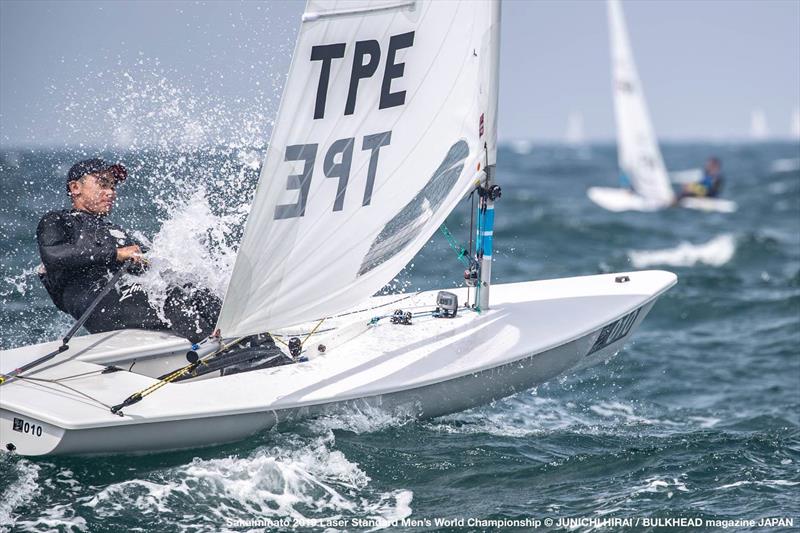
The Laser's rise as an international class was further solidified when it became an Olympic class in 1996. The boat's simplicity, strict one-design nature, and large worldwide fleet have made it a staple of the Olympic sailing program.
Its design has remained relatively unchanged since its inception, with only minor modifications being made to improve performance and durability .
The Laser remains a popular choice for sailors globally, both competitive and recreational. Its unique combination of simplicity, adaptability, and performance has ensured its continued success as a one-design class, and the International Laser Class Association continues to play a crucial role in maintaining the consistency of the boat and promoting the sport of sailing around the world.
Laser Sailboat Specifications
Hull Design and Construction
The Laser sailboat is known for its simplicity and performance which was designed in 1970 by Ian Bruce and Bruce Kirby. The hull design contributes to its stability and speed in the water.
Its construction uses a lightweight hull, ensuring optimal handling for sailors of various skill levels. This sailboat has been designed with durability and stability in mind.
Its materials and construction techniques focus on withstanding the rigors of sailing while maintaining a consistent and smooth ride on the water.
Rigging Variants
There are three interchangeable rigging variants for the Laser sailboat, each offering different sail areas to accommodate sailor weight and wind strength. These variants include:
- Laser 4.7 : With a sail area of 4.7 square meters, this rig is suitable for youth and lighter female sailors. It is considered the smallest and most accessible rig for Laser sailing. More information about Laser 4.7.
- Laser Radial : This rig offers a 5.1 square meter sail area, suited for women and lighter sailors seeking a more challenging sail size. Learn about Laser Radial.
- Laser Standard (ILCA 7) : The most common and originally designed rig using a 7.1 square meter sail, also known as MK2 , features a larger sail area suitable for heavier and more athletic sailors. Details on Laser Standard sail and rig.
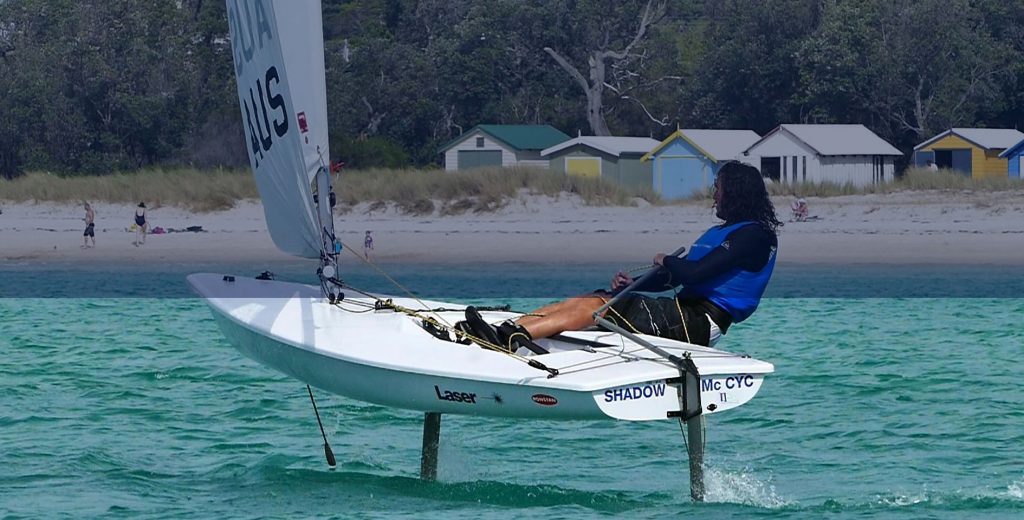
Dimensions and Sail Measurements
The Laser sailboat has specific dimensions and sail measurements which contribute to its design and performance. Here are the key dimensions:
- LOA (Length Overall): 4.2 meters
- LWL (Length at Waterline): 3.81 meters
- Beam : 1.39 meters
- Draft : 0.787 meters
- Weight : Standard 58.97 kg (130 lbs)
The sail measurements for the three different rigging variants are as follows:
| Rig Variant | Sail Area (sqm) |
|---|---|
| Laser 4.7 | 4.7 |
| Laser Radial | 5.1 |
| Laser Standard | 7.1 |
These specifications ensure consistent performance and ease of handling for sailors in various conditions and preferences.
Sailing Dynamics and Performance
Handling and Maneuverability
The Laser sailboat is known for its excellent handling and maneuverability, making it suitable for sailors of all skill levels.
Its simplified rigging and straightforward design allow for easy control and quick response to changes in wind and water conditions.
The Laser's hull weight is only 120 pounds (54.43 kg), contributing to its nimbleness on the water.
Steering the Laser sailboat is mostly dependent on the sailor's body positioning and sail trimming techniques, giving more room for tactical excellence. Due to its responsive nature, the Laser rewards sailors who can make quick adjustments and maintain an optimal sail trim.
Speed and Stability
The Laser sailboat offers a good balance of speed and stability for both recreational and competitive sailing.
Its relatively simple design, combined with a large sail area of 75 square feet (6.97 square meters) , enables it to reach impressive speeds for its size while maintaining stability.
Key factors affecting the Laser's speed and stability include:
- Hull design: The Laser's hull is designed to reduce drag and enhance stability, providing a fast and steady sailing experience.
- Sail size and shape: The Laser's sail is optimized for various wind conditions, allowing it to perform well in both light and strong winds.
- Sailor's weight and athleticism: The speed and stability of a Laser sailboat are also influenced by the sailor's weight and athleticism. An optimal weight range for Laser sailors is 140 to 190 pounds (64 to 86 kg) , and experienced, athletic sailors can better handle the boat in challenging conditions.
Sailor Interaction
A significant aspect of the Laser sailboat's performance is the level of interaction between the sailor and the boat.
As mentioned earlier, the Laser rewards sailors who possess excellent steering and trimming techniques, as well as a strong sense of tactical awareness.
This interaction allows the Laser to perform at its best under various conditions.
Sailors can further optimize their Laser sailboat's performance by:
- Adjusting the sail's angle and position to match wind conditions
- Proper body positioning and weight distribution
- Adopting efficient upwind and downwind sailing techniques
- Maintaining focus and awareness of wind shifts and changes in water conditions
Types of Laser Sailboats
Laser sailboats are a type of one-design dinghies, which means that they follow strict design and manufacturing rules to ensure all boats in the Laser class are identical.
The versatile laser class is widely popular as they offer different sail and rig sizes, catering to sailors of various ages, weights, and skill levels.
Laser Standard
The Laser Standard , also known as the ILCA 7 , is the largest of the three laser rigs. This adult racing class boat features a 7.1 sqm sail, making it suitable for heavier and more athletic sailors.
Laser Radial
The Laser Radial or ILCA 6 has a smaller 5.1 sqm sail. It is specifically tailored to lighter sailors, including women and youth sailors. The Radial's sail allows for better control and easier handling in various wind conditions.
This provides a level playing field for a wide range of sailors in terms of age, weight, and experience level.
Lastly, the Laser 4.7 or ILCA 4 features the smallest sail, measuring 4.7 sqm. This rig is designed for young sailors who are new to Laser sailing and need a more manageable sail size. The unique 4.7 lower mast section includes a pre-bend near the boom fitting, which allows the sail to depower more easily.
This provides a more forgiving experience for new and younger sailors.
Each Laser sailboat variant utilizes the same hull design, ensuring that the core sailing experience remains consistent across the board. This enables sailors to transition seamlessly between the different rig sizes as they progress in their sailing abilities.
Competitive Sailing
Racing and Regattas
The Laser sailboat has been a popular choice in the sailing community for competitive racing due to its simplicity and one-design class. The Laser Class Association organizes races and regattas in various formats where sailors adhere to the class rules.
The laser class has three different sail sizes - Laser Standard (ILCA 7), Laser Radial (ILCA 6), and Laser 4.7 (ILCA 4). These cater to sailors of different ages, weights, and abilities to participate in a single class.
These characteristics make the Laser sailboat a widely sought-after option for sailors who are interested in competitive racing 1 .
Olympic Presence
The laser class has a strong presence in the Olympics, being recognized as an Olympic class sailing dinghy. Laser Standard (ILCA 7) and Laser Radial (ILCA 6) are the two divisions that have been part of the Olympic Games since 1996 and 2008, respectively.
With its universal appeal and the level playing field it offers to sailors, the laser class has grown significantly in popularity over the years. It has achieved global recognition as a highly competitive sailing class in the Olympic Games.
National and International Championships
Alongside racing, regattas and their Olympic presence, the Laser Class Association also organizes various national and international championships.
Among these events are the ILCA 4 Youth World Championship, scheduled to happen in Viana do Castelo, Portugal, in June 2024 2 .
The World Championships typically attract top sailors from different nations, competing for the title of world champion.
A list of major championships for laser sailing includes:
- ILCA 4 Youth World Championship
- ILCA 6 World Championship
- ILCA 7 World Championship
In addition to these flagship events, many national championships are also held regularly by various Laser Class Associations around the world. This fosters the growth of talented sailors and promotes the spirit of competition within the laser sailing community.
Maintenance and Upkeep
Routine Care and Maintenance
Laser sailboats are known for their durability, but regular maintenance is essential to ensure their longevity and maintain resale value.
Inspect the hull and foils for any damage or signs of wear. Also, check the steering systems, such as rudder and tiller, ensuring they are functioning smoothly without any wiggles.
Regularly inspect tiller extension fittings for cracking and signs of potential breakage.
Cleaning your sailboat after each use will help minimize the chance of damage from dirt, salt, and debris. Store sails, lines, and other equipment properly to avoid moisture damage, mold, and mildew growth.
Verifying the functionality of the autobailer should also be a part of the routine maintenance process.
Transport and Storage
Transporting a Laser sailboat can be done with relative ease, as they are lightweight and their compact size allows for cartop transport.
When cartopping your Laser, use appropriate padding and straps to secure the boat without causing damage to the hull, mast, or other components.
As for storage, it is essential to keep your Laser sailboat in a covered and well-ventilated area, preferably on a dolly or custom cradle that supports the gunwales to prevent unnecessary stress on the hull.
Moreover, ensure the mast and other equipment are safely stored alongside the boat.
Periodically inspect the boat during storage to check for any signs of damage, moisture buildup, or rodent infestation.
Laser Sailboat Community and Culture
The Laser sailboat has built a strong sense of community that extends across different countries. This community primarily revolves around clubs, associations, and social and recreational sailing.
Clubs and Associations
A significant part of the Laser sailing community is the involvement in clubs and associations at various levels. The International Laser Class Association (ILCA) is the governing body that brings together Laser sailors from all around the world.
This association is responsible for maintaining the one-design principles, organizing international events, and promoting Laser sailing as a high-quality, competitive sport.
At a local level, numerous clubs are home to passionate Laser sailors. Club racing is a popular form of competition within the community, offering a friendly yet competitive environment for sailors to test their skills.
There are also regional associations supporting the growth of the Laser sailing community in their respective areas.
Example of Laser clubs:
- Family Fun Sailing Club : Focused on promoting sailing for the whole family and organizing social events.
- Weekender Club : Emphasizes weekend gatherings and collaborative sailing initiatives.
- TGIF Racing Club : Prioritizes Friday evening club races for those looking to engage in competitive sailing after work.
Social and Recreational Sailing
The Laser sailboat's appeal extends beyond competitive racing, with many enthusiasts enjoying the boat for its simplicity and versatility in social and recreational sailing.
The Laser community is known for organizing events that cater to various interests and skill levels, ensuring that everyone has a chance to find their niche.
Some common social and recreational sailing events include:
- Casual group sails : Informal gatherings where sailors can share tips, learn from one another, and enjoy sailing in a relaxed and social environment.
- Adventure sails : Excursions to explore new sailing locations or participate in long-distance trips.
- Family fun days : Sailing events focusing on family-oriented activities, making the sport accessible and enjoyable for all ages.
Frequently Asked Questions
What factors determine the price of a Laser sailboat?
When looking for a Laser sailboat, various factors such as brand, condition, materials used, size, and additional features all play a role in determining the price .
A brand-new Laser will typically cost more than its used counterpart. Higher quality materials and improved technology can also increase the price, as well as customizable options and additional accessories.
To find the right Laser sailboat at a competitive price , it's essential to compare offerings from various vendors and take time to evaluate factors like reputation and warranty. Sailing Chandlery provides more information on Laser sailboats and their prices.
What are the essential specifications to look for in a Laser sailboat?
When considering a Laser sailboat, pay attention to details like hull weight , rig size, sail size, and weight capacity , as these will affect the boat's performance and suitability for the intended use.
A standard Laser sailboat generally has a hull weight of 125 lbs or 56.7 kg , with different sail sizes available, such as ILCA 4 (Laser 4.7), ILCA 6 (Laser Radial), and ILCA 7 (Laser Standard).
Each sail size is designed for sailors within specific weight ranges, providing the best performance and stability.
How can I find a reputable vendor for Laser sailboat kits?
To find a reputable vendor for Laser sailboat kits, research different suppliers, seek recommendations from fellow sailors, and read reviews from previous customers.
Online platforms like West Coast Sailing offer resources and information on Laser sailboats, including detailed guides, FAQs, and where to find quality suppliers.
What is the recommended weight capacity of a standard Laser sailboat?
The recommended weight capacity for a Laser sailboat varies depending on the rig size.
The ILCA 6 (Laser Radial) is suitable for sailors between 60 kg and 75 kg , while the ILCA 7 (Laser Standard) is better suited for sailors weighing 75 kg to over 90 kg.
The ILCA 4 (Laser 4.7) is designed for younger and lighter sailors. When choosing a Laser sailboat, ensure that the rig size matches the intended user's weight range for optimal performance.
What are the characteristics that define the best Laser sailboats on the market?
The best Laser sailboats on the market offer a combination of durability, performance, and ease of use.
Look for models with robust construction. They are made from high-quality materials to withstand harsh sailing conditions.
Additionally, seek sailboats with easy-to-use rigging systems and low-maintenance designs.
Also, make sure they have support from reputable manufacturers. This ensures they meet strict class specifications.
Is sailing a Laser suitable for beginners and what are the challenges involved?
Sailing a Laser is generally suitable for beginners. These boats are known for their simplicity, ease of use, and responsive handling. However, beginners should be prepared for some challenges.
These challenges include mastering the correct body positioning and balance or adjusting to different wind and weather conditions. It's essential for new Laser sailors to familiarize themselves with the boat's assembly and rigging process and seek guidance from experienced sailors or trainers. This ensures a safe and enjoyable sailing experience.
Related Articles
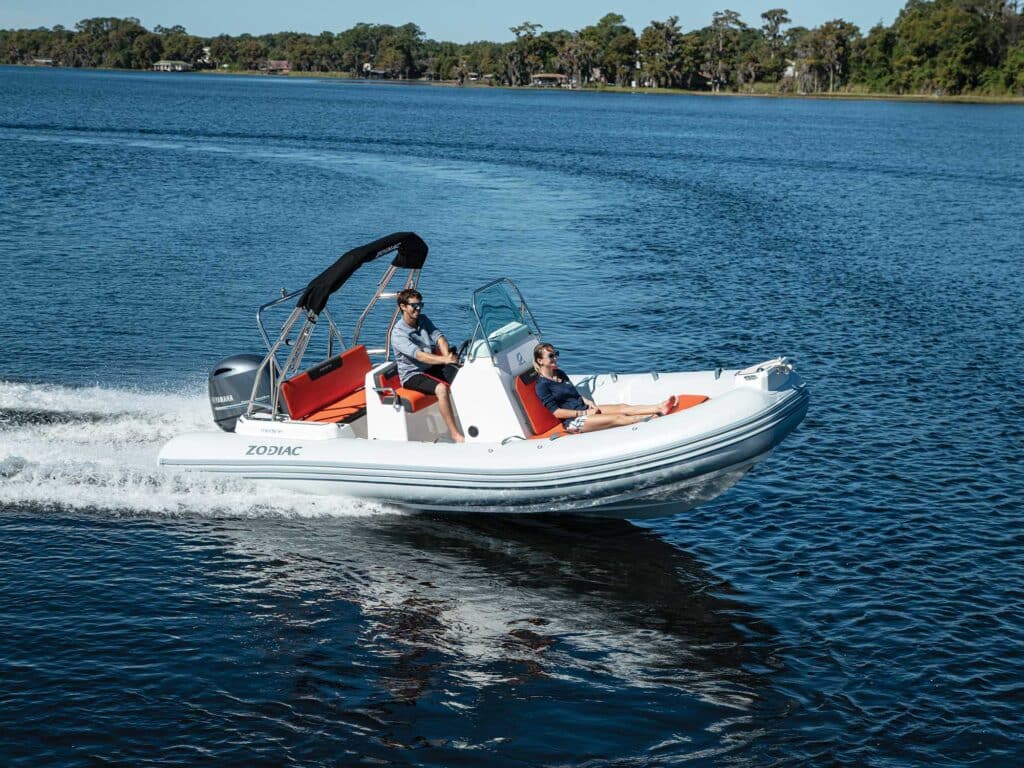
Zodiac Boat: Essential Features and Top Models Explained
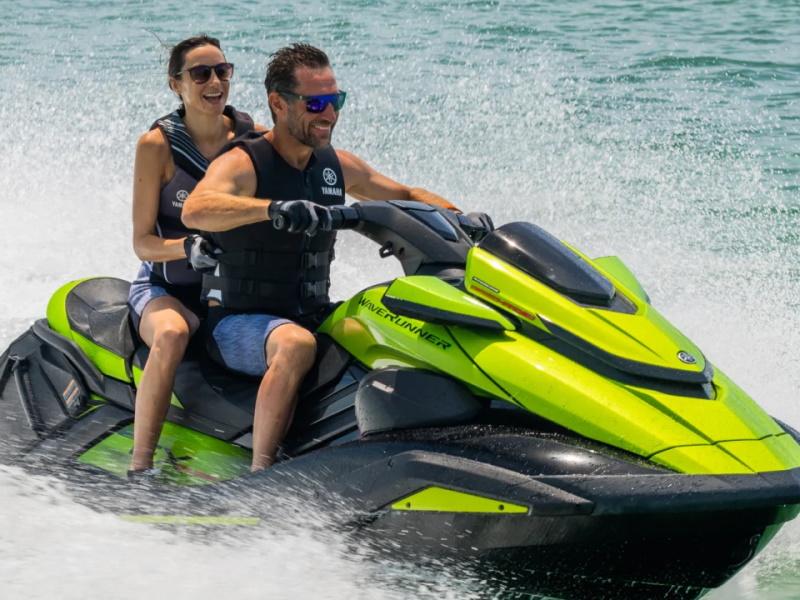
Which Action May Cause Loss of Steering Ability in a PWC? Essential Safety Tips
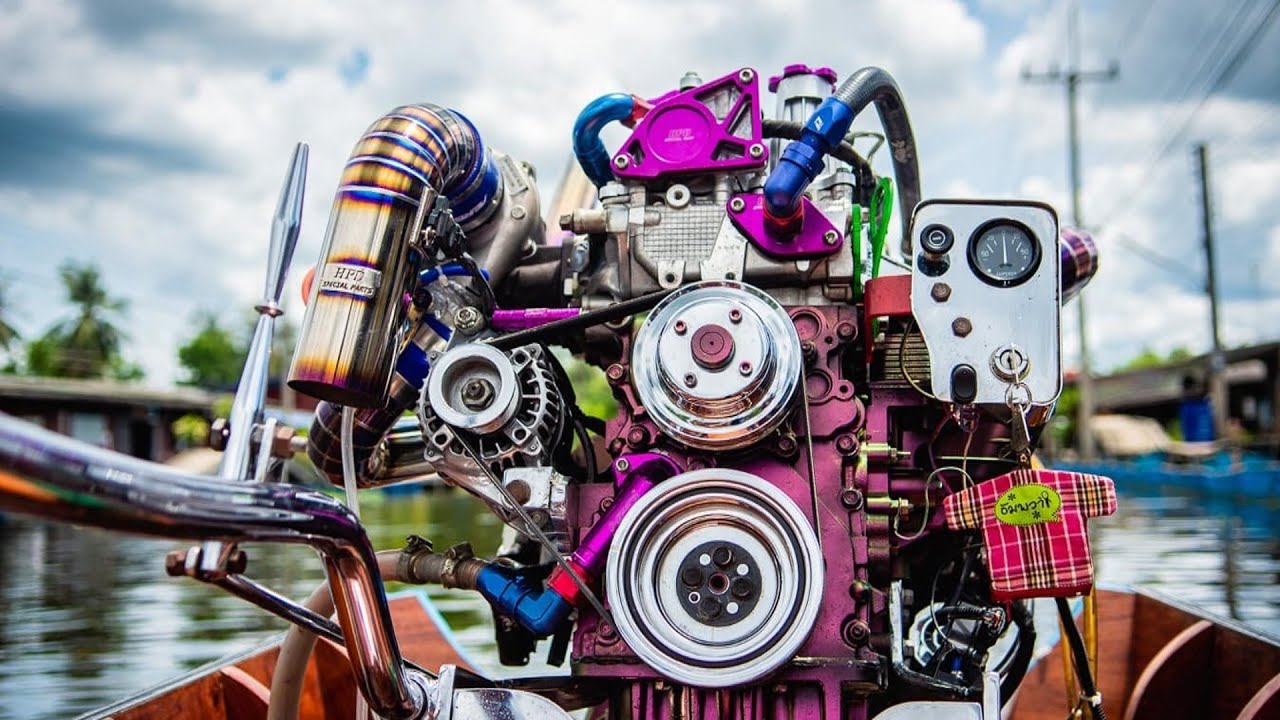
Long Tail Turbo Boats Thailand: Exploring High-Speed River Navigation

4.3 MerCruiser: Essential Maintenance for Optimal Performance

Rare Fish - Top 10 Astonishing Finds Beneath the Waves

The Art of Beach Boat Parking

Boating Tubes: Ultimate Guide for Thrilling Water Adventures

Parts of a Boat: Essential Components Explained

What Is A Laser Sailboat? (Understanding The Basics)

Sailing has been a popular pastime for centuries, and today, the modern laser sailboat is the perfect combination of tradition and technology.
If youve been curious about the world of sailing, understanding the basics of laser sailboats is the perfect place to start.
In this article, we will cover everything you need to know about laser sailboats, from features and advantages to types and costs.
Well also discuss the basics of laser sailboat maintenance, as well as racing.
So, whether youre a novice sailor or an experienced yachtsman, lets dive into the world of laser sailboats and learn about this exciting and popular sport.
Table of Contents
Short Answer
A laser sailboat is a type of sailboat that is designed to take advantage of the power of laser technology.
It is a single-handed, small sailboat that is designed to be sailed with minimal crew and minimal equipment.
The hull is designed to be lightweight and sleek, providing the boat with maximum speed and maneuverability.
Laser sailboats are especially popular in competitive sailing and have become a staple of the sailing community.
What is a Laser Sailboat?
A Laser sailboat is a small, one-person sailing dinghy that is designed specifically for light wind conditions.
It features a single sail, without the need for a jib or trapeze, and is typically used for competitive racing.
This type of sailboat is very maneuverable and can reach high speeds, making it perfect for the experienced sailor who is looking for an exciting and challenging sailing experience.
The Laser sailboat is designed with convenience in mind, making it easy to transport and store.
It is also relatively lightweight, so it can be maneuvered and sailed in a variety of conditions.
Additionally, the minimal design and low cost of a Laser sailboat make it an excellent choice for sailors of any skill level.
The key to sailing a Laser sailboat successfully is understanding the basics of how the boat works.
The sail is the main propulsion of the boat, and the sailor must be able to adjust the sail and trim it to the wind to maximize the boats speed.
The sailor must also be able to adjust the boats weight distribution and the center of gravity shifting weight from one side of the boat to the other, depending on the direction of the wind to ensure the boat remains stable.
Finally, the sailor must be able to read the wind and anticipate the conditions in order to position the boat correctly.
With the basics down, the laser sailboat can provide an exciting and challenging sailing experience.
Whether youre an experienced sailor looking for a fast and maneuverable boat for racing, or a beginner looking for an easy and accessible boat to learn on, the Laser sailboat is an ideal choice.
Features of a Laser Sailboat

A laser sailboat is an ideal choice for sailing enthusiasts of all levels.
Its lightweight design, minimal components, and low cost make it a great option for those looking for an exciting and challenging experience.
The boat is designed for light winds, with a single sail and no jib or trapeze.
This makes it highly maneuverable and fast, allowing for quick tacks and jibes.
Additionally, the boat is easy to transport, so sailors can travel to different locations and explore different sailing conditions.
The laser sailboat is built with a strong, lightweight hull, allowing it to move efficiently through the water.
The hull is usually made of fiberglass or carbon fiber, making it durable and easy to maintain.
The single sail is made of specialized materials that are designed to be lightweight and durable, while still providing enough power to propel the boat.
The boat also features a rudder and centerboard, which provide additional control and stability.
When it comes to performance, the laser sailboat is well-known for its competitive racing capabilities.
The boat is fast and maneuverable, making it ideal for tight races and close finishes.
It also features a simple design, so it is easy to learn and navigate.
Additionally, the boat is low-maintenance, so sailors can focus on enjoying the experience without worrying about upkeep.
Overall, the laser sailboat is an excellent choice for sailors of any skill level who are looking for an exciting and challenging sailing experience.
Its lightweight design, minimal components, and low cost make it an ideal choice for those who want to learn the basics of sailing or hone their racing skills.
With its simple design and competitive capabilities, the laser sailboat is a great way to enjoy the thrill of sailing.
Advantages of a Laser Sailboat
A laser sailboat is a great choice for sailors of any skill level looking for an exciting and challenging sailing experience.
With its minimal design and low cost, the boat offers a variety of advantages over other types of sailboats.
First, the boat is lightweight and easy to transport.
Its small size and lack of jib or trapeze make it much easier to move and store than larger, more complex sailboats.
This also makes it an ideal choice for sailors who dont have access to a marina or other large body of water.
Another advantage of the laser sailboat is its maneuverability.
The single sail and lack of any additional rigging allow the boat to turn quickly and efficiently, making it an ideal choice for competitive racing.
Its minimal design also makes it more agile in light winds, allowing it to move faster and more easily than heavier boats.
Finally, the laser sailboat is relatively inexpensive, making it an ideal choice for sailors on a budget.
Its low cost also makes it a great option for beginners who want to get into sailing without a large up-front investment.
Overall, the laser sailboat is an excellent choice for sailors of any skill level looking for an exciting and challenging sailing experience.
Its low cost, lightweight design, and maneuverability make it an ideal choice for competitive racing or casual sailing.
With its minimal design and easy transportability, the laser sailboat is a great choice for sailors of any skill level.
Types of Laser Sailboats

There are several types of laser sailboats, each with different features and designed for different sailing conditions.
Each type of laser sailboat is designed to provide an exciting and challenging sailing experience.
The standard Laser sailboat is the most popular type, and is designed for light winds and a wide variety of sailing conditions.
It features a single sail, and is easy to transport and maneuver.
It is an ideal choice for beginners and experts alike, as it has a simple design and is relatively low cost.
The Laser Radial is a popular version of the standard Laser sailboat, designed for lighter winds and smaller bodies of water.
It has a slightly smaller sail area than the standard Laser, and is designed for single-handed sailing.
The Laser Radial is an ideal choice for sailors who want to race in light winds and smaller bodies of water.
The Laser 4.7 is another version of the Laser sailboat, designed for younger sailors.
It has a slightly smaller sail area than the standard Laser, and is designed for single-handed sailing in light-to-moderate winds.
The Laser 4.7 is an ideal choice for younger sailors who want to experience the thrill of racing in a small, maneuverable sailboat.
The Laser Bahia is an even larger version of the standard Laser, designed for heavier winds and larger bodies of water.
It has a larger sail area, and is designed for two-handed sailing.
The Laser Bahia is an ideal choice for experienced sailors who want to race in heavier winds and larger bodies of water.
Finally, the Laser Performance is a high-performance sailboat designed for experienced sailors.
It has a larger sail area than the other Laser sailboats, and is designed for two-handed sailing in heavier winds.
The Laser Performance is an ideal choice for experienced sailors who want to race in the most challenging conditions.
Whether you are a beginner or an experienced sailor, there is a laser sailboat designed to meet your needs.
With its minimal design and low cost, the laser sailboat is an excellent choice for any sailor looking to experience the thrill of competitive sailing.
Laser Sailboat Maintenance
Maintaining a laser sailboat is an important part of owning and sailing one.
It is essential to keep the boat in good condition to ensure maximum performance and safety.
Regular maintenance will also extend the life of the boat and ensure it is always ready for the next sailing adventure.
The first step in proper laser sailboat maintenance is to inspect the boat regularly.
This includes checking the hull, deck, and rigging for any signs of wear or damage.
It is also important to check the sail for any signs of damage or wear, and to ensure that all of the lines and rigging are in good condition.
Regularly inspecting the boat will help to identify any problems before they become serious.
Another important part of maintaining a laser sailboat is to keep the boat clean.
This includes wiping down the hull, deck, and rigging with a damp cloth to remove any dirt or salt buildup.
It is also important to clean the sail and other parts of the boat with a mild detergent.
This will help keep the boat in top condition and ensure that it will perform as expected when sailing.
In addition to regular cleaning and inspection, it is also important to perform regular maintenance on the boat.
This includes replacing any worn or damaged parts, such as the sail, lines, and rigging.
It is also important to check the boat for any signs of corrosion or wear on the hull, deck, and rigging.
Additionally, it is important to check the boats mast and spars for any signs of wear or damage.
Finally, it is important to store the boat in a dry and secure location when not in use.
This will help to protect the boat from weather, sun, and other elements.
It is also important to cover the boat when it is not being used, as this will help to keep it clean and in top condition.
By following these simple steps, it is possible to keep your laser sailboat in top condition.
Regular cleaning and inspection will help to identify any potential problems before they become serious, while regular maintenance will help to ensure the boat will perform as expected when sailing.
Storing the boat in a safe, dry location will also help to protect it from the elements when not in use.
With proper care and maintenance, a laser sailboat can provide an exciting and challenging sailing experience for years to come.
Laser Sailboat Racing

Laser sailboat racing is an exhilarating and exciting experience for sailors of all skill levels.
It is a unique form of sailing that allows for fast-paced, competitive racing in small, light-wind boats.
The design of the laser sailboat is simple, with a single sail, no jib or trapeze, and minimal rigging, making it easy to transport and handle.
The boat is also highly maneuverable, allowing for tight turns and quick acceleration, which makes it an ideal choice for competitive racing.
When sailing a laser sailboat, sailors must be aware of the wind direction and strength in order to maneuver effectively.
The boats light-wind design allows it to sail in conditions as low as 3 knots, but in higher winds, the boat must be adjusted accordingly.
Racers must also be aware of the other boats in the race, as collisions and jostling are common.
Most laser sailboat races are organized into fleets, with each fleet racing against each other in a series of races.
The fleet leader is determined by the sailors total points from each race, with the lowest score winning.
In addition, the top three finishers in each race are awarded points based on their finishing order.
Points are also awarded for completing the race, so even if a sailor does not win the race, they can still gain points.
In addition to competitive racing, laser sailboats are also popular for recreational sailing.
The boat is easy to transport and can be sailed in a variety of conditions, so it is a great choice for those who want to try out sailing or just enjoy the experience of being out on the water.
Overall, laser sailboat racing is an exciting and challenging experience for sailors of all levels.
With its minimal design and low cost, the laser sailboat is an ideal choice for anyone who wants to experience the thrill of competitive sailing.
Cost of a Laser Sailboat
When it comes to the cost of a Laser sailboat, there is a wide range of prices depending on your budget and the type of boat you are looking for.
Generally speaking, a basic Laser sailboat will cost anywhere from $3,000 to $10,000.
If you are looking for a high-end boat, with all the bells and whistles, you could be looking at spending up to $25,000.
When purchasing a Laser sailboat, it is important to consider the extra expenses that come with owning and operating a boat, such as maintenance costs, dock fees, and insurance.
It is also important to note that the cost of a Laser sailboat can vary greatly depending on the condition of the boat and the features included.
For example, some boats may include a trailer, sails, rigging, and other accessories, while others may require additional items to be purchased separately.
Additionally, some boats come with a warranty, while others do not, so it is important to understand what is included in the package before making a purchase.
Ultimately, the cost of a Laser sailboat will depend on your budget and what type of sailing experience you are looking for.
With a wide range of prices and features, there are Laser sailboats available to meet the needs of any sailor, from beginners to experienced racers.
Final Thoughts
A laser sailboat is a great option for sailors of any skill level looking for an exciting and challenging sailing experience.
With its minimal design and low cost, a laser sailboat is capable of racing in a variety of conditions and is easy to transport.
With the knowledge you now have on laser sailboats, why not give it a try? Whether you’re looking for the thrill of racing or just a leisurely sail, the laser sailboat experience can be enjoyed by all.
James Frami
At the age of 15, he and four other friends from his neighborhood constructed their first boat. He has been sailing for almost 30 years and has a wealth of knowledge that he wants to share with others.
Recent Posts
When Was Banana Boat Song Released? (HISTORICAL INSIGHTS)
The "Banana Boat Song" was released in 1956 by Harry Belafonte. This calypso-style song, also known as "Day-O," became a huge hit and remains popular to this day for its catchy tune and upbeat...
How to Make Banana Boat Smoothie King? (DELICIOUS RECIPE REVEALED)
To make a Banana Boat Smoothie King smoothie at home, start by gathering the ingredients: a ripe banana, peanut butter, chocolate protein powder, almond milk, and ice. Blend the banana, a scoop of...
Your cart is empty
Have an account?
Log in to check out faster.
Best Sellers

ILCA (Laser) Sailing 101
What is the ilca (laser) class.
Note: In this article, the terms "Laser" and "ILCA" are going to be used interchangeably. Worldwide, the class is now officially known as the ILCA, despite originally being called the Laser .
The Laser class is a one design dinghy originally designed by Bruce Kirby and Ian Bruce in 1969. Although the original intent behind the design was a recreational, family-friendly boat, the Laser has gone on to become one of the most popular racing boats in the world, with over 220,000 produced.
What makes up a boat?
Being a one design and Olympic class, all Laser boats conform strictly to the Laser class rules. In order to compete at continental and international championships, you will need to ensure that your equipment is ILCA class certified, and complies with the measurement standards set out by the class. There is a number of non-class legal equipment available, and if you're just planning on sailing for fun, these are a great option for getting started. (Hint: google Intensity Sails)
A relatively lightweight hull for its size, the Laser is 4.23m long, has a beam of 1.42m and weights 57kg. All hulls are built from glass reinforced plastic (AKA fibreglass) and are known for their robust construction and light weight.
One of the unique features of the Laser class is the three different rigs which can all be used with the same hull. This allows sailors of different ages, weights and abilities to participate in a single class. The rigs are:
Laser Standard (ILCA 7)
Laser Radial (ILCA 6)
Laser 4.7 (ILCA 4)
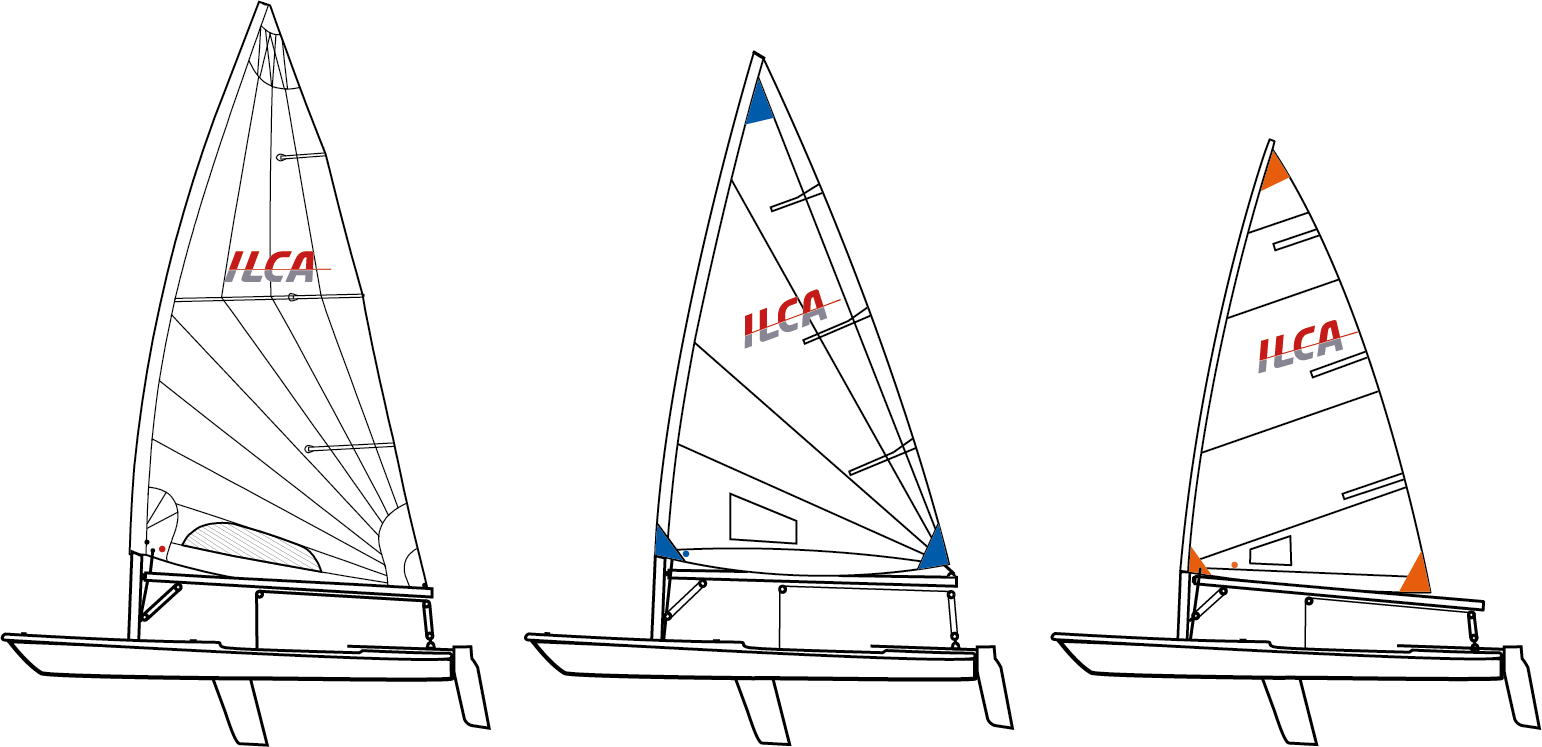
Masts/Spars
Each Laser rig consists of three pieces - the bottom mast, top mast and boom. The bottom mast is specific to each rig size, but the same top section and boom can be used with all three rigs.
Similar to the bottom mast sections, each Laser rig also has its own sail, and they are all different sizes.
Control Lines and Rigging
In the early 2000s, the class introduced the Turbo Kit rigging, which made a significant difference in the techniques and ease of sailing the boat. Although the Turbo rigging is standard nowadays, the old systems can still be found, and can be used to race.
One thing that many sailors like about the Laser is the speed and simplicity of its rigging. The boat has only four main control lines: the mainsheet, vang (kicker), cunningham and outhaul.
Similar to the hull, ILCA foils are also made from fibreglass. The centreboard (daggerboard) is inserted in to the case aft of the mast step, and the rudder clips easily on to the gudgeons on the transom of the hull.
Accessories
Launching trolley - unless you will be beaching (not recommended) or storing your boat on a dock, you will need a trolley to launch your boat. Most boats are sold with these.
Road Trailer - if you would like to sail at different venues, or compete away from home, one of the easiest ways to transport your boat is with a road trailer. The Laser was originally designed to be loaded on to the roof of a car, and if you would like to find out more about transportation methods, we have a full article here .
Tiller and Extension - these come in both aluminium and carbon varieties, and both can be used to race.
Clothing - you can wear anything while sailing the Laser, but I would recommend getting at least a life jacket (better safe than sorry), and a pair of hiking pants. Hiking pants will protect the back of your legs from the deck, and allow you to sail for longer.
Who Can Sail the Laser?
Another great things to mention about the Laser is the range of uses and abilities the boat caters to. Lasers can be sailed on the weekend with your family for fun, or raced in the Olympics and everything in between!
What is the optimal weight for the Laser?
Thanks to the three rig sizes in the Laser class, the weight range in the Laser is quite large. Generally, the Laser Radial (ILCA 6) is suitable for sailors between 60kg and 75kg while the Laser Standard (ILCA 7) is suitable for sailors 75kg to over 90kg. The Laser 4.7 (ILCA 4) is designed specifically for younger and lighter sailors with an optimal weight range between 45kg - 60kg.
What ages are the sailors?
Laser sailing is a sport you can do for life, and nearly every Laser regatta there will be an age category catering to everyone from junior sailors through to master ages. Generally the age categories are U19, Open (20-35), and Masters (over 35). Depending on the regatta, there may also be additional age divisions including U17, and U15. It’s never too late to start sailing a Laser!
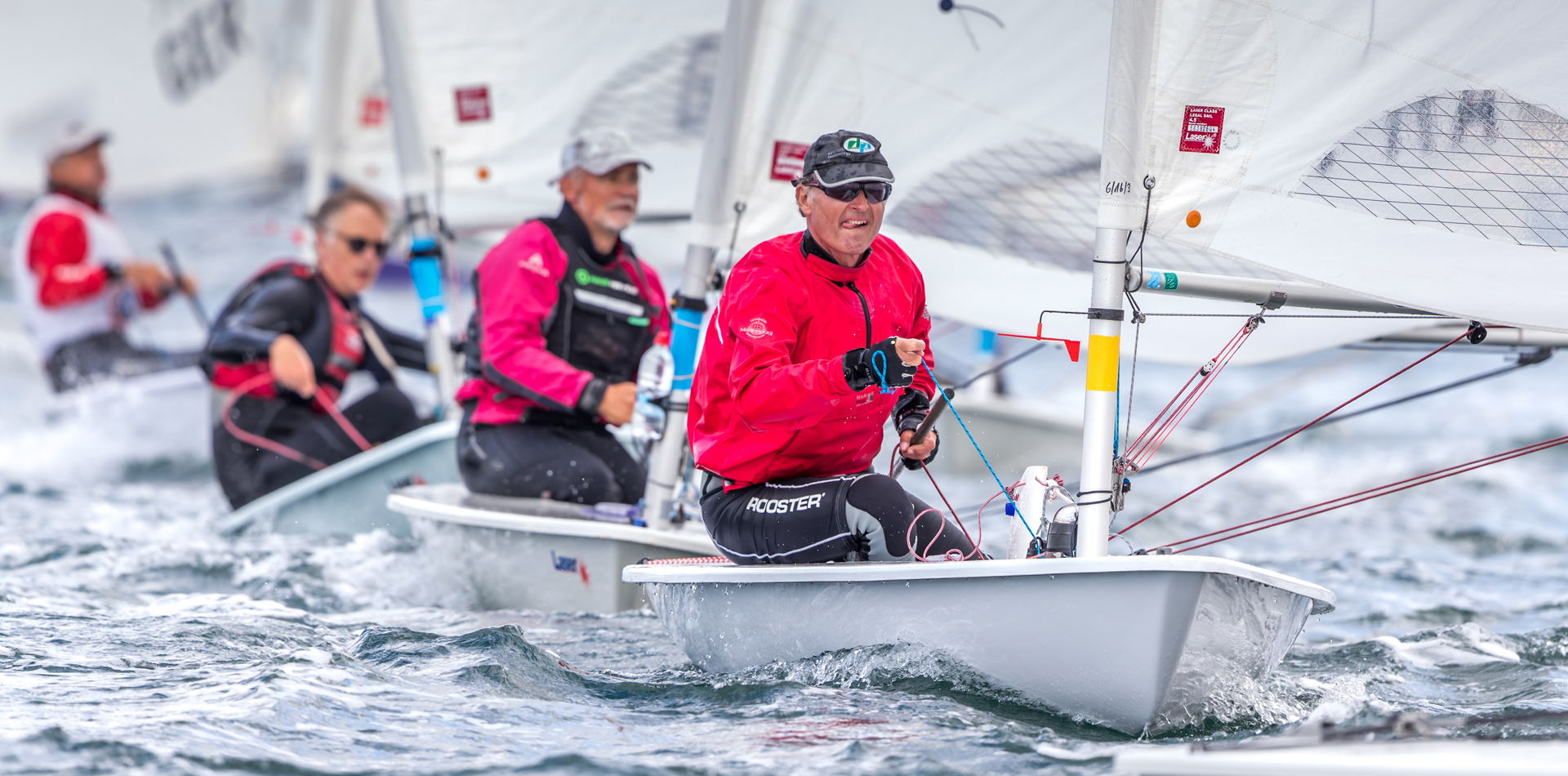
Where to Sail a Laser?
The Laser world is divided in to 6 different regions:
North America
Central and South America
Rest of World
with each region comprising of various member countries and districts. Being the most popular dinghy class in the world, there are Lasers in over 120 countries around the world, and it's likely there is a sailing club with at least one boat near you. For more information and contact details for an association in your country, ILCA have a directory of ILCA District Contacts .
Laser Racing
Since the inception of the class, the Laser has been considered one of the world's premiere racing classes thanks to its low-cost, availability and one design nature providing tight competition at all levels. Since 1996, Laser racing has been included at the Olympics, and many Olympic laser sailors have gone on to the pinnacles of high performance sailing. If you want to see the calibre of some of the sailors who have competed in the Laser, be sure to check out our ranking of the Top 10 Male Sailors and Top 10 Female Sailors of all time.

Outside of the Olympics, the ILCA class also organises World Championships for all rigs and age divisions on a yearly basis. These include the following regattas:
Masters World Championship (all divisions and rigs)
U21 World Championship (ILCA 6 and ILCA 7)
ILCA 4 Youth World Championship
ILCA 6 Women's World Championship
ILCA 6 Youth World Championship
ILCA 6 Men's World Championship
ILCA 7 Men's World Championship.

The full list and dates of upcoming ILCA World Championships can be found on the ILCA website .
Each ILCA region also hosts their own continental championships, and these also have a typically high attendance, and strong calibre of racing. The list of championships for each of the regions can be found here:
Oceania (out of date)
Starting Out with ILCA Sailing
If you're now feeling ready and excited to kick off your Laser journey, here's some things you might want to know before getting on the water
Getting a Boat
Due to their popularity, nearly every sailing club around the world will have at least one Laser lying around which you could try out before you buy your own boat. Many clubs also have rental programs where you can borrow or lease their boats for a minimal cost. This is a great way to get started and see if you enjoy the class.
If however, you're already at the point where you want to get your own boat, there will also be plenty of second hand boats which you could consider upgrading to. If you want some advice on looking for a used Laser, we have a complete second hand Laser Buyer's Guide .
Alternatively, I may have done such a good job convincing you to start ILCA sailing that you're ready to throw yourself in to it headfirst and buy a new boat. If that's the case, contact me at daniel.self@sail27 .com and I can help you find the best boat for you, or connect you with a great Laser dealer in your area.
Training and Coaching
Regardless of your ability, getting a coach is going to help you improve your sailing and much faster than you would by yourself. There are plenty of ILCA coaches all around the world, and the best resource I have found for finding a coach is ILCA's Coach directory . Another great option is to talk to your local sailing club or ILCA district association - they're sure to know someone in your area who can help you get started in the class.
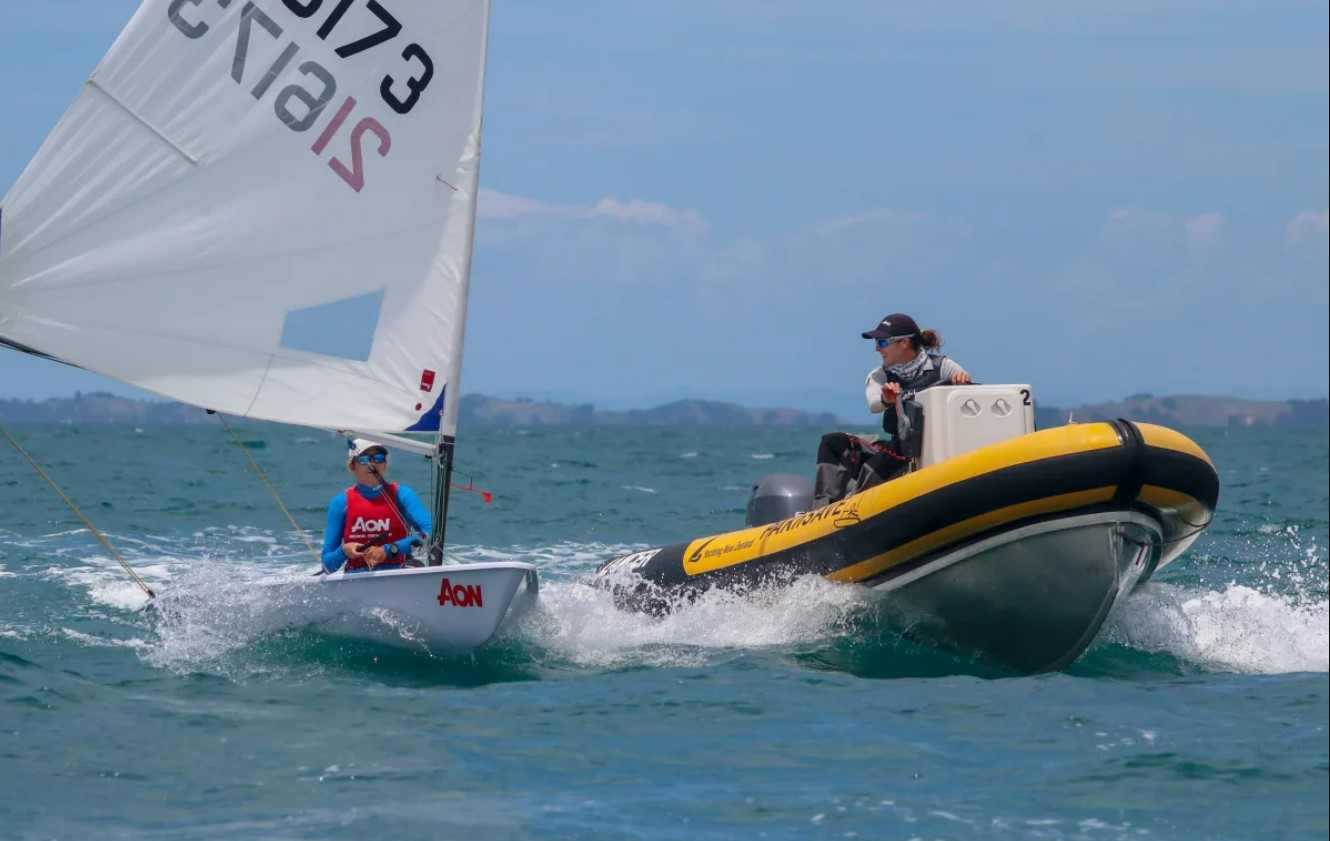
Since the COVID pandemic, online Laser coaching has become more accessible, and the guys at the International Sailing Academy have some great courses which can help you get from an intermediate to advanced Laser sailor.
You may however still be more of a 'book person' (that's how I started as well). If that's the case, I would recommend the RYA Laser Handbook. Although its a little older now, this is the most comprehensive guide to Laser sailing that I've read. Even as I got further in to my sailing journey, I would often refer back to this book for new tips.
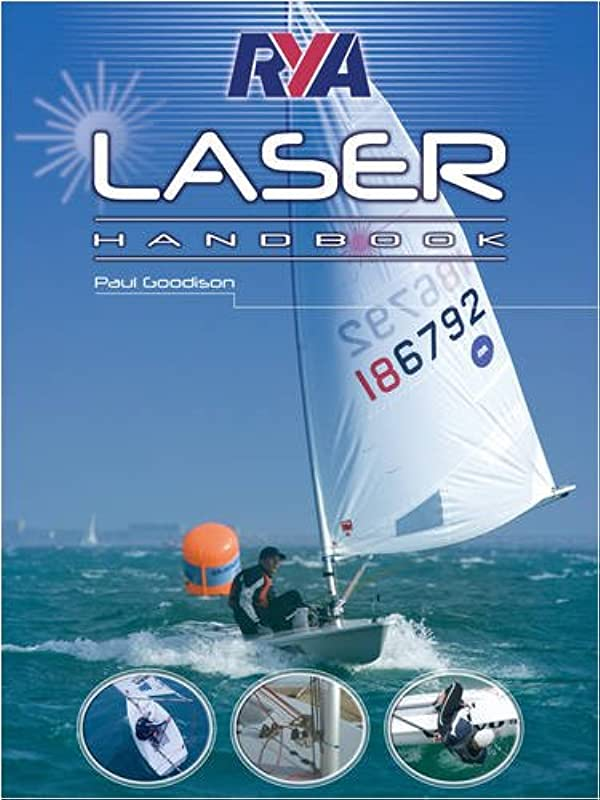
Wrapping Up
With all of that information, you should now be well versed on the ILCA class, and how you can get started in it. If you need any further information, feel free to comment below and I'll try to answer as well as possible. Otherwise, happy sailing and I'll see you on the water sometime soon!
Leave a comment
Please note, comments need to be approved before they are published.
- Choosing a selection results in a full page refresh.
- Opens in a new window.

Guide to Laser Pico’s and Dinghy Sailboats
- Home / Category / Active
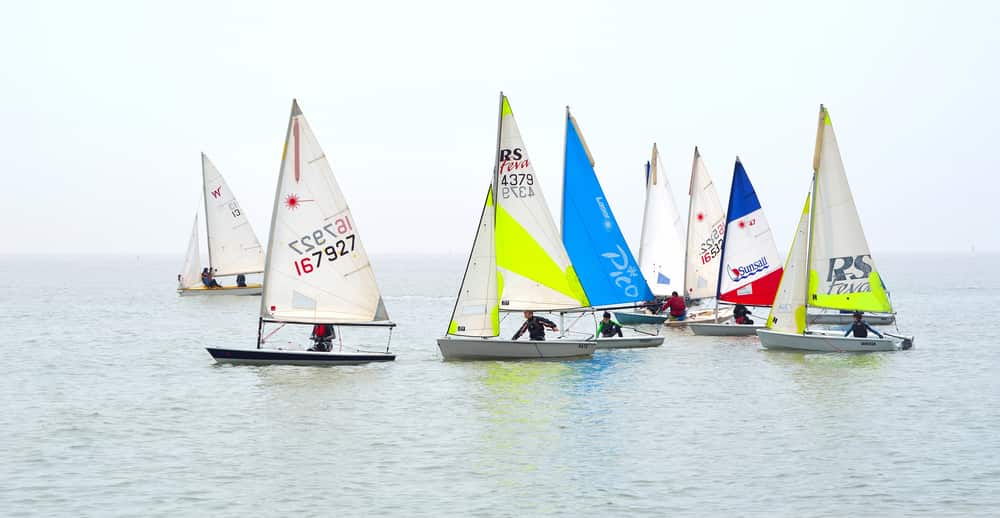
- March 25, 2022
- Author: Robert Puharich
The laser boats were first produced at the beginning of the 1970s and attained the Olympic sailing category in 1996. Since then, these boats have become the most competitive sailing boats designed in history.
For this reason, all laser boats are constructed with similar specifications, including their sails, equipment, and hulls. The laser Pico and Dinghy Sailboats are among the common types of laser boats you can use to test your skill as a sailor and advance in this hobby.
Most starters may ask, how do these boats operate? How many people can they hold? Are they expensive? And what’s the difference between the two? If these are your concerns, you’re at the correct place.
This article provides everything there is to know about laser Pico’s and dinghy laser boats to help you know which is the most suitable one for your sailing hobby.
The Laser Pico
Developed primarily for fun, the Laser Pico has constantly remained the prevalent sailboat of all times and abilities. The boat is easy to use and rig and facilitates a speedy learning curve, making it easier for a single sailor to utilize it comfortably.
The boat was first designed by an Olympic medallist known as Jo Richards and was built in 1998 by LaserPerformance . Current Pico models use the latest manufacturing process to ensure it offers nothing but the best experience while on water.
The Laser Pico is the best option for both novice and savvy sailors. The boat alienates the pressure of newcomers having to spend hours learning how to use it. The modern Pico is very simple to rig and sail that a beginner can master how it works in a day.
It’s rare to find a boat with the combination of features and qualities found in Laser Pico’s. For beginners, this laser sailboat is vice free, simple, and stable enough that almost anyone can easily use it. However, pro users will delight in its brisk performance and highly responsive nature.
Pico is true to its size and rides with a smooth motion regardless of its flat underwater outline and flared bow sections. It doesn’t require great intricacy when steering or trimming due to its well-built rig and enormous rudder.
The boat has positive and well-balanced steering that offers precise feedback for the sailor, and is made to quickly notice forces that are out of balance. Its hiking straps are suitable even for bare feet, while the curved decks work well for people with different leg lengths.
The Laser Dinghy
A dinghy refers to a small open boat often towed or carried on larger ships and used as a tender or lifesaving boat. Other dinghies are usually designed for sailing, and the best example is the Laser Dinghy sailboat.
The Laser Dinghy, also known as the Laser Standard or the Laser One, was first designed in 1970 by Bruce Kirby, with more emphasis on performance and simplicity. The boat is in the international class and used by sailors in more than 120 countries.
Its popularity and wide acceptance come from its simplicity to rig, sailing ease, and robust construction. Its numerous features and great association controls make it a competitive sailing boat.
Usually, most people use the word ”Laser” to describe the Laser Standard, the largest plan rigs you can find for the Laser hulls.
But there are other types of Laser Standard sail plan rigs and many Laser-branded boats with entirely dissimilar hull designs, such as the Laser Pico and Laser 2. The Laser Class Association only offers three kinds of Laser boats: the Laser Standard, Laser 4.7, and Laser Radial.
All Laser boats are constructed with similar specifications and are usually light enough to be carried on top of car racks. However, they are suitable for people of different sizes and ages.
For instance, the Laser Standard is best for fit, muscular, and agile sailors weighing over 80kgs. On the other hand, Laser 4.7 and Laser Radial sailboats are good for small sailors with less weight.
Features to Look for When Purchasing a Sailboat
With many manufacturers producing dinghies today, you’d want to ensure the one you purchase is the best the market offers. For a starter, it’s easy to buy a second-rate or poorly constructed sailing boat if you aren’t careful.
Some of the essential features to check are:
1. Sailboat Number
Most dinghies have sailboat numbers on their cockpit’s back or the deck. These numbers usually help to identify the age and quality of the sailboats. The newer ones tend to have the numbers etched on their cockpit’s backs, while the older dinghies have these numbers written on their decks.
2. The Deck and Hull Condition
It’s important to ensure that the deck and hull of the sailboat you purchase are in good condition. It would be better to watch out for any deep scratches and cracks as they’re the primary tell-tale indications of leaking and damages on the boat.
Usually, this number includes three letters followed by a series of numbers and letters. The first three letters are normally the production date, while the remaining five are the sail serial number.
3. Stiffness
Stiffness is used in boats to indicate their ability to withstand heeling forces. A stiff is boat is usually more stable and responds rapidly to wave profile. However, the stiffness usually diminishes with use and time; hence could tell you the sailboat’s overall quality. Softer ones are more likely to leak.
4. Mast Step
The mast step takes the highest pressure from the sail and mast. A mast’s primary purpose is carrying the soars, derricks, sails, and offering the required height for a lookout position, signal lamp, navigation light, and radio aerial. Therefore, it’s important that the mast step of the boat you buy is in good condition.
5. Other Parts of the Boat
Besides the parts mentioned above, it’s always best to make sure other parts of the laser sailboat you buy are in excellent condition. Examples of these parts are the rudder, daggerboard, mast and boom, and tiller and tiller extension. You should check them for straightness and inspect the ropes and sails for wear and tear.
Why Pico Sailing Is an Extremely Fun Hobby
Laser Pico is the most exciting and capable boat you can ever sail with. It features a:
- Robust dacron sail
- Simple reefing system
- A reefing mainsail and removable jib
- Stable and stiff roto-molded hull, and more
- Four-padded toe straps
These features, plus the boats superb design, high durability, and stiffness, make it a great choice for beginners and experienced sailors. Anyone can rig and sail it easily, and most first-time users are normally in charge of them after several days of use.
It’s surprisingly fast and accelerates briskly on the water with a good amount of breeze. Pico’s daggerboard fits easily and can clear the kicking strap and boom even when raised fully, allowing simple lee shore launching and preventing any foul-ups when gybing .
The Laser rudder system utilizes the famous swing-down-and-lock-with-the-tiller arrangement, fastened with a bungee cord you can replace easily. Its hull is produced using the latest process for higher stiffness and durability to ensure safety and longevity.
Therefore, you can expect to have a lot of fun and memorable sailing moments with your Laser Pico for years to come. Its high-capacity allowance and cockpit size are sufficient enough for you and your youngster to go sailing together and teach them more about this fun hobby.
Although the hull of this boat is slightly heavier, its durability and numerous essential features still make it a world-class sailboat. It’s fun, exciting, simple to use, modestly priced, and simple to maintain.
What’s The Best Beginner Laser Sailboat?
The laser boats come in different sizes and types. However, these boats have similar specifications since they’re built to be competitive sailboats to gauge sailors’ skills. Several factors determine the best Laser boat for you, including your age, weight, and experience level.
The Laser sailboats come in three main types; the Laser Standard, 4.7, and Radial. There are also two other types not formally recognized as the Laser class. The main types are designed for sailors with different weight capacities. Below is more comprehensive detail about them:
1. Laser Standard
This Laser bought is the one discussed above, also called the Laser Dinghy. It’s built for sailors weighing 70-84kgs.
2. Laser Radial
Laser radial is slightly smaller than Laser Standard. It’s the one utilized during the 2008’s Women singlehanded Dinghy Olympics and is suitable for people weighing 55-72kgs.
3. Laser 4.7
Laser 4.7 is smaller than the Laser Dinghy, and its shape differs from Laser Radial. It’s built for sailors with a weight of 50-55 kgs.
Two Other Types of Laser Sailboats Include:
Laser M is the rare Laser sailboat model with a smaller hull designed for smaller sailors. Its mast is short, making it a bit challenging to use and depower, particularly with stronger winds.
2. Rooster 8.1
This type of Laser is produced in the UK, and it features a larger hull meant for larger sailors. It’s constructed with varying mast length options.
The first three rigs differ in size, with the Standard measuring 76 sqft, the Radial being 62 sqft, and the 4.7 is 51 sqft. All these boats are suitable for different people. Usually, the Laser Standard is good for advanced sailors, the Radial is ideal for intermediate sailors, and the 4.7 is best for young sailors getting started with the hobby.
What’s The Weight of a Laser Sailboat?
The optimal weight for laser boats differs with each type. Generally, a standard Laser boat should weigh between 55-72kg.
Laser Vs. Laser 2- What’s The Difference?
The main difference between a Laser and Laser 2 is that the latter has a double-handed design while the first one is single-handed. Also, the laser 2 should be sailed with a jib, or else there will be excess weather helm, and it may fail to move.
The Laser 2 is also bigger than the standard Laser, and it can run a jib, main, and spinnaker. Its cockpit is larger and can accommodate even two adults; however, sailing it alone is tricky.
Winding-Up Laser Pico’s and Dinghy Sailboats
The laser boats are excellent options for anyone wanting to hone or learn their sailing skills and enjoy the hobby more. They’re highly responsive, well-built, simple to use, move briskly, the right size, and fun to sail in moderate and light winds, even for beginners.
However, you need to select the right type to be safe and have the utmost fun. Usually, you need to consider your age, weight, and skill set before purchasing one. Have fun sailing!
Search this website
Latest articles.

Is Basketball a Hobby?
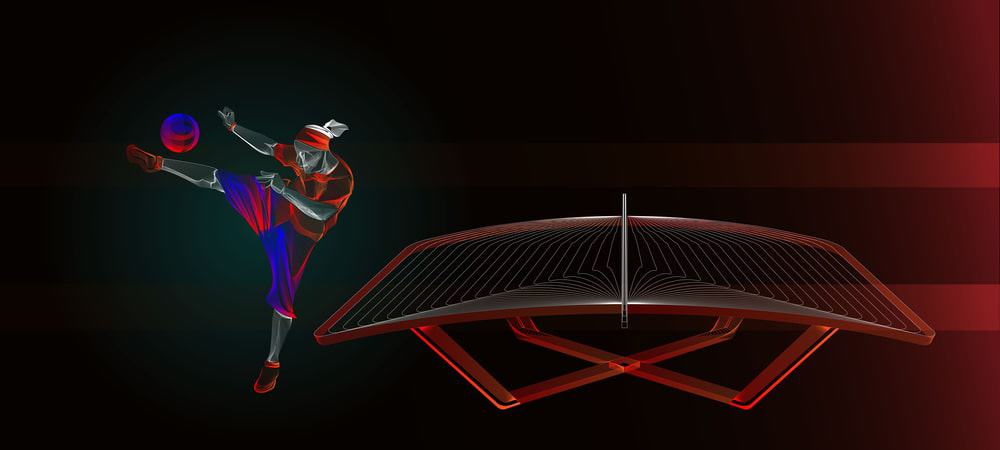
What is Teqball? Your Guide to a New Sport

29 Problem Solving Hobbies to Keep Your Mind Busy

How to Play Tchoukball | A Beginners Guide

Is Working Out a Hobby? Find Out Here

25 Best Hobbies for Men Over 60

Exotic Pole Dancing: A Creative, Athletic Hobby

Is Listening to Music a Hobby? Consider this…

25 One Handed Hobbies to Try
Share this article: , keep up with new hobbies.
Boat Care And Upgrades
Buying And Selling
Destinations

A Comprehensive Guide to Buying a Laser Sailboat
Introduction to laser sailboats.
Laser sailboats are among the most popular single-handed dinghies in the world. They are known for their simplicity, durability, and performance, making them an excellent choice for both novice sailors and experienced mariners. This guide will assist you in understanding the fundamental aspects of buying a Laser sailboat.
Understanding the Features of a Laser Sailboat
A Laser sailboat typically features a 4.23-meter length hull, weighing approximately 59 kg, making it portable and easy to manage. It’s equipped with a single sail, typically ranging from 4.7 to 7.06 m² based on the rig variant, which makes it versatile for different sailing conditions and sailor's abilities.
Rig Variants
Laser sailboats are known for their unique three rig variants - Standard, Radial, and 4.7. Each of these rigs is designed to accommodate different wind conditions and sailors of varying weights. Make sure to understand your sailing requirements and choose accordingly.
Checking the Condition of the Boat
Like any used item, a second-hand Laser sailboat will have signs of wear and tear. Always ensure to examine the hull for any damages, dents, or repairs. Other areas to pay close attention to include the mast step, deck, and sail. A damaged mast step or a frayed sail could lead to major issues while out on the water.
The Importance of a Professional Inspection
While it's possible to do a basic inspection yourself, having a professional surveyor examine the boat is often a wise decision. They can detect potential problems that might be missed by the untrained eye, saving you from costly repairs in the future.
Researching the Market Price
Knowing the current market price of Laser sailboats is essential to avoid overpaying. Prices can vary significantly based on factors such as the boat's age, condition, and included equipment. It's a good idea to review listings on several boat trading websites to get a sense of the average price for the model you're interested in.
Navigating the Purchase Process
When you're ready to make the purchase, remember to prepare a written bill of sale that includes the full details of the boat, the agreed price, and the signatures of both parties. It's also a good idea to check if the boat is subject to any outstanding finance or liens.
Owning a Laser Sailboat: Costs and Considerations
After acquiring your Laser sailboat, it's crucial to understand the ongoing costs and responsibilities associated with ownership. These include maintenance, storage, and insurance.

Maintenance and Repairs
Even though Laser sailboats are renowned for their durability, regular maintenance is key to prolonging their lifespan. This includes rinsing the boat after each use, periodic hull inspections, sail care, and hardware checks. Always budget for potential repairs and part replacements.
Storage Solutions
Storage is another significant consideration. Ideally, your Laser sailboat should be stored in a dry, shaded place when not in use. Depending on your location and available space, you might need to rent storage space at a local marina or boatyard.
Safeguarding your investment with the right insurance coverage is crucial. Insurance policies for sailboats can vary widely in cost, depending on factors like the boat's value, your sailing experience, and the insurance company's policies. Research different providers and choose a policy that suits your needs and budget.
Enhancing Your Sailing Experience: Accessories and Upgrades
Investing in quality accessories can significantly enhance your Laser sailing experience. Consider additions like a high-quality buoyancy aid, comfortable sailing footwear, and a sturdy boat cover for protection during storage. Furthermore, you can also explore upgrades like performance-enhancing rigging systems or a new sail to improve speed and control.
Joining a Sailing Community
One of the joys of owning a Laser sailboat is the vibrant and inclusive community that comes with it. Joining a local sailing club or an online community can offer numerous benefits. These range from opportunities to participate in races and regattas to learning from experienced sailors and forming lasting friendships.
Wrapping Up: Embarking on Your Sailing Adventure
Equipped with the right knowledge and a keen eye for detail, you are now prepared to venture into the rewarding journey of Laser sailboat ownership. Remember, the seas may not always be calm, but with the right boat and a positive mindset, every wave becomes an opportunity to learn and grow as a sailor.
Ready to hoist the sail and embrace the thrilling world of Laser sailing? Then it's time to dive in and make your dream a reality!

You may also be interested in:

Bertram Boats: A Comprehensive Buyer's Guide
By Derek Caldwell

Expert Tips for Buying a Used Cabin Cruiser
By Ben Hunter

Comprehensive Guide to Buying and Selling Boat Engines

A Comprehensive Guide to Buying Sailboats from Owners
By Poppy Harvey-Fitzgerald

Guide to Finding Small Sailboats for Sale

How to Choose the Perfect Boat Lift for Sale: A Comprehensive Guide

Essential Tips for Buying a Used Houseboat from an Owner

Scarab Boats: A Buyer's Guide - Understand Your Options

Guide to Buying and Selling Outboard Motors

The Truth About Free Boats: Is It Worth It?

The Best Fish and Ski Boats for Sale in 2023

The Ultimate Guide to Buying a Hydrofoil
International Laser Class Association
One Boat, One Sailor, One Design.

Introduction to Laser Sailing
by Jon Emmett
The Laser is truly the boat for all ages from our Junior 4.7s to our legendary (over 75 year old) Masters. No other adult class is raced in more countries in the World, in a class which takes grass roots to Olympic sailors. Come and join us to see why!
Not only are there nearly 215, 000 boats out there at the time of writing, but there is truly something for everyone in a combined class which covers the competitive weight range for nearly everyone from junior to adult, although it is not just about racing. Lasers form a key part of many sailing holiday fleets for people who just want to blast or potter around for fun.
Many of the world’s best sailors, difficult to mention them all, have come through the Laser rank. It seems like medalling in an international Laser event means you are likely to be able to medal in future classes as Laser sailors go on to compete in nearly every aspect of the sport. Ben Ainslie, Iain Percy, Paul Goodison, Robert Scheidt, Francesco Bruni, Tom Slingsby are probably the best known, and with so many to choose from it is hard to know where to start. Behind them, there is a whole host of talent with the level just getting higher and higher.
Photo by Jon Emmett
The inspiration for a young sailor joining the fleet is there for all to see. Yet for the Masters, the competition is in a way no less fierce and keeping active in older age is recommended on so many levels. After all, Laser sailing has been compared to cycling, so it certainly keeps testing you both physically and mentally, and the Masters’ European circuit continues to go from strength to strength.
The core skills you learn in Lasers: the starting, the tactics, and the fitness lifestyle are for life, not to mention the ability to surf downwind whilst within Rule 42, and navigate every type of wave upwind in a non-planing boat. We are always learning, and this is the reason the Laser remains as popular today as when it was first launched as a beach boat in 1969.
It is not only about having a rig for every weight but competition for every level. Of course, this varies from region to region. Another beauty of the Laser is the ability to jump on a plane and charter a boat when you get to the regatta. Due to the class’s numbers, there is no other class where this option is so widely available.
So, whether your aim is simply to have fun on those warm sunny days when the wind allows you to plane freely without getting blown off the water, or you have the Olympics firmly set in sight, there are step-by-step routes to success.
Club sailing: There are very few dinghy clubs anywhere in the world without a Laser or two, meaning that fleet racing is possible. This really is the true test of skill, racing against someone in an identical boat. Whilst handicap racing has its place and means, we can race our friends who are of very different body weights or sail very different boats, this is a far from perfect system because an overpowered boat will always tend to do well in light winds and an underpowered boat do well in strong winds, especially if it has a trapeze and can plane upwind!
Europa Cups are not only for European sailors. Indeed, we see many sailors from all over the world attend these and they make an excellent stepping stone to other international events. More and more, the other regions are having their own circuits of events.
Europeans: In recent years, probably the greatest depth of competition has been found in the European region, meaning those from other regions will travel to participate not only in the EurOlym regattas (Olympic class events in Europe) with world class venues such as Garda, Medemblik, Kiel, as well as the European Championships (and Open Trophy) themselves. For example, in Asia we have the Asian Games, in America the Pan-American Games.
For more information please see http://www.eurilca.eu/
However other regions are working hard to catch up.
Some useful links: Europe http://eurilca.org/
Asia http://www.asiansailing.org/
North America www.laser.org/
Australia http://www.lasersdownunder.com/
Worlds: For some, just qualifying for the Senior Worlds is a massive task, with the level going up and up and up. However, Laser sailing really does have World Championships for everyone with Junior (4.7), Youth, Under 21, and of course the other end of the scale, Masters’ Worlds! For more information please see http://www.laserinternational.org/
Perhaps the biggest Worlds is the Sailing World Championships run by World Sailing every 4 years, which features all Olympic classes, and sitting roughly in the middle of the Olympic cycle is the major country qualifier for the Olympics.
World Cups: Being an Olympic class, both the top Laser and Radial sailors will do the invitation only World Cup Series, which also forms a very important part of the World Sailing ranking (as these World Cup events generate a lot of ranking points). The circuit currently visits Asia, North America, Europe with a final, for an even further reduced number of sailors counting all three events. For more information, please see http://www.sailing.org/ .
Jon Emmett is an Olympic Gold medal-winning coach, guiding Lijia Xu from China to Gold in the Laser Radial class at the 2012 Olympic Games in London. He also sails competitively himself in worldwide regattas when he has the time. Check out his Facebook page, Jon Emmett Sailing, where he posts his latest training videos: https://www.facebook.com/jonemmettsailing/

- O’pen Skiff Purchase Page
- ILCA – Element 6
- RS Sailboats
- Sunfish – Recreational
- Sunfish – Race Version
- Sunfish Sails
- LaserPerformance Sunfish Parts Price List
- 420 – Zim Sailing
Finding the Right Laser Rig: Formula
- Racks by Dynamic Dollies and Racks
- Load Rite Trailers
- Load Rite Sunfish Trailer
- **NEW** LoadRite for Sailboats
- Sunfish Dolly by Dynamic
- Optimist Dolly by Dynamic
- How to Apply Laser Sail Numbers
- Applying Laser Sail Numbers
- North Sails for LaserPerformance Dinghies
- About/Contact
Choices of Rigs for your Laser Hull :

Finding the Right Laser Rig – 3 Choices:
Now this is where it becomes a bit interesting because all three rigs fit and work exceptionally well with the Laser hull. Any sized sailor can sail with one of these rigs in most conditions and have fun. But what if you are thinking competitively? What is optimal for you? The quick and simple formula is this:
- 4.7 Rig – Designed for smaller sailors 110 – 140 lbs. (50 – 65 kg).
- Radial Rig – Used as the women’s Olympic class, and designed for sailors 140 – 175 lbs. (65-80 kg).
- Full or Standard Rig – Used as the men’s Olympic class, and designed for sailors 165 lbs.+ (75 kg+).”Olympic sailors are in the 180 lbs. range but club sailors do well weighing in over 200 lbs. in certain conditions.” Paraphrased from propercourse.blogspot.com
Laser 4.7 Rig:
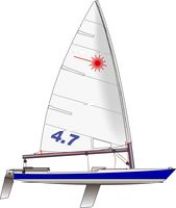
Laser Radial Rig:

A look at the hardware that changes the 3 rigs:
The Upper Mast section on the left side in this drawing is identical for all 3 rigs. It mates together with the other lower 3 mast section choices shown at the right. These parts are all available from Shoreline Sailboats along with class legal sails. The lower mast sections come with a gooseneck and vang tang; completely ready to go.
No matter which rig you choose, the Laser is a challenging boat that rewards athleticism, subtle steering, and trimming techniques, as well as tactical excellence.
Share this:
- Click to email this to a friend (Opens in new window)
- Click to share on Facebook (Opens in new window)
- Click to share on Twitter (Opens in new window)
- Click to print (Opens in new window)
- Click to share on Pinterest (Opens in new window)
- Click to share on LinkedIn (Opens in new window)
- Click to share on Tumblr (Opens in new window)
- Click to share on Reddit (Opens in new window)
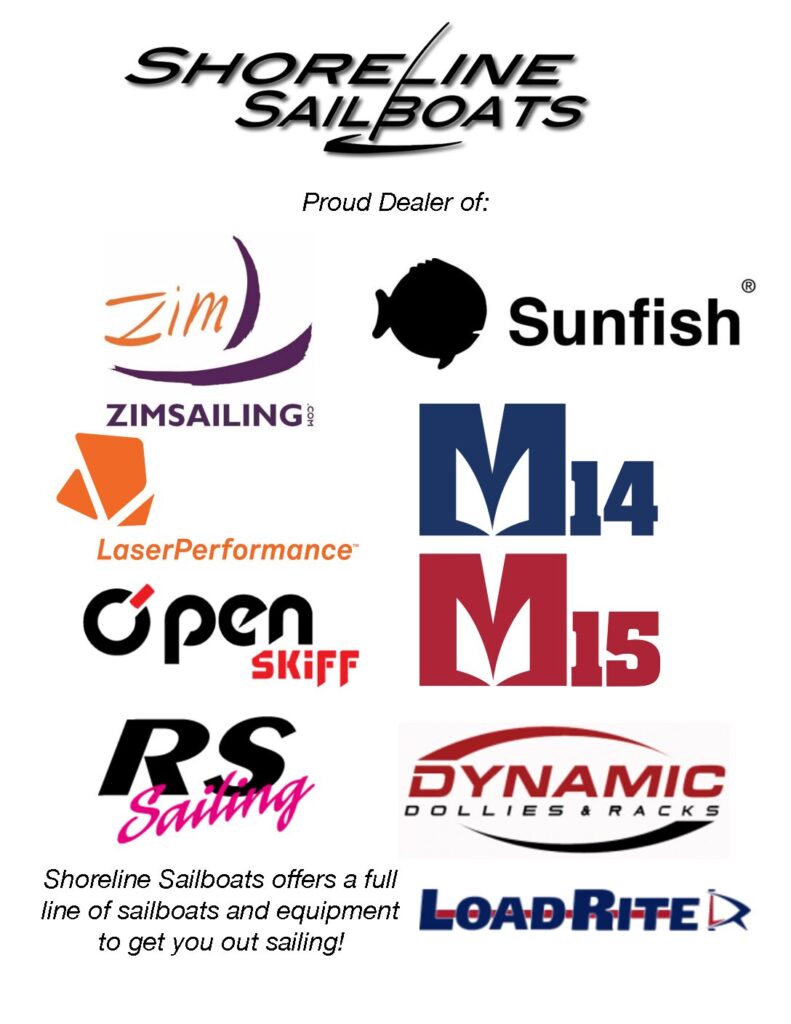
THE MELGES 15!
THE ROCKET! Built in the USA
SUNFISH – SAIL A CLASSIC!
Recent Posts

Hours & Info
Search products.
Contact us:
Any questions about the sailboats we sell, or the services we provide? We’re always eager to talk sailing and would enjoy helping you with any of your sailing needs. Contact Us
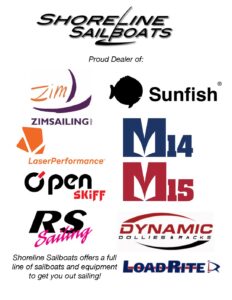
Designed by WPZOOM
- Sailing Jackets
- Sailing Trousers
- Sailing Shorts
- Fleeces & Midlayers
- Sweatshirts & Tops
- T-Shirts & Polos
- Spraytops & Smocks
- Dinghy Boots
- Buoyancy Aids
- Dinghy Gloves
- Dinghy Headwear
- Sailing Boots
- Deck Runners
- Footwear Care
- Changing Robes
- Swimming Gloves
- Swimming Socks
- Swimming Goggles
- Safety Buoys
- Changing Mats
- Victorinox Swiss Army
- Clothing Care
- Flasks & Sports Bottles
- Sea Sickness Aids
- Paddleboarding
- Water Toys & Towables
- Clocks & Barometers
- Model Boats
- Brass Bells
- Clothing Gifts
- Miscellaneous
- Clothing Specials
- Clothing Clearance
- Lifejackets
- Lifejackets Accessories & Re Arm Kits
- EPIRBs & PLBs
- Lifebuoys & Liferafts
- Safety Accessories
- Winch Handles
- Tillers & Extensions
- Cleats & Clutches
- Wind Indicators
- Topper Hardware
- Topaz Boats Hardware
- ILCA / Laser Hardware
- Optimist Hardware
- All Dinghies
- Epoxy & Fillers
- Cleaning Products
- Bilge Pumps
- Dehumidifiers
- Stain Removers
- Water Treatment
- Shackles & Stainless Steel Fittings
- Navigation Lights
- Deck Equipment
- Inspection Hatches
- Pilots & Sailing Directions
- Charts & Navigation
- Instructional Reading
- Knots & Rope Work
- Technical Books
- Dinghy Books
- Bunkside Reading
- Kids Reading
- Topside Paint
- Paint Accessories
- Race Compasses
- Anemometers
- Shore Power
- Torches & Head Torches
- NKE Marine Electronics
- Gift Vouchers
- Sailing Dinghies
- Outboard Engines
- Electric Outboards
- Inflatable Dinghies
- Lubricants & Engine Oil
- Fuel Treatment
- Outboard Accessories
- Gift Voucher
- Offshore Sailing

- Fleeces & Midlayers
- Sweatshirts & Tops
- T-Shirts & Polos
- Spraytops & Smocks
- Flasks & Sports Bottles
- Water Toys & Towables
- Clocks & Barometers
- Lifejackets Accessories & Re Arm Kits
- EPIRBs & PLBs
- Lifebuoys & Liferafts
- Tillers & Extensions
- Cleats & Clutches
- Epoxy & Fillers
- Shackles & Stainless Steel Fittings
- Pilots & Sailing Directions
- Charts & Navigation
- Knots & Rope Work
- Torches & Head Torches
Which Laser sail is best for me, and what are they made from?

What is a Laser Dinghy?
A laser is a single - handed ILCA dinghy which is 4.2m in length and weighs 56.7kgs. It is one of the most popular single - handed dinghies in the world due to its simplicity and affordability. This class is protected by the strict one-design class rules which ensures no changes are allowed to be made to the boat unless they are specifically mentioned in the class rules. The laser is an Olympic class boat which first made an appearance in Atlanta in 1996. The class ensures the one - design rules allow sailors to excel based on their ability to sail the boat, not the condition of the sails etc. This one design rule means that if a laser hull is maintained the resale value of a laser remains very high.
The laser has a standard hull design with three different types of sails. This allows sailors to progress depending on their ability and weight and height, making it a boat that can be sailed for many many years by all ages. These rigs are known as ILCA 4, ILCA 6, ILCA 7 or otherwise more commonly known as 4.7, radial and standard rig.
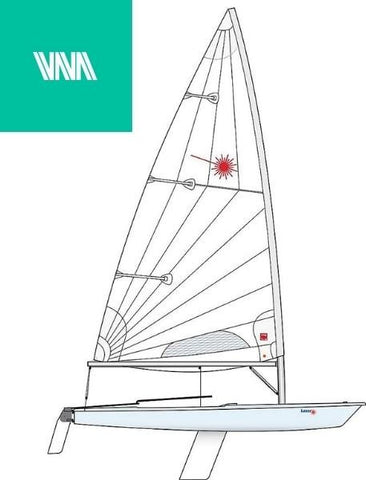
Which Laser rig is best suited for me?
The laser has a two part mast, allowing for interchangeable bottom sections as well as a sleeved sail which allows for easy rigging. This is unlike other dinghies which require extensive preparation in relation to rig set up.
The Laser 4.7 (ILCA 4) sail uses a short pre-bent lower section which in turn reduces the sail area by 35% compared to the standard rig. This creates a more balanced helm which compensates for the fact the sailor is lighter than a standard rig helm. This allows helms to learn the basics of sailing as a beginner and also provides sailors with a boat to transition into after smaller dinghies such as an optimist. This rig is ideal for lighter weighted sailors 35-55kg. This is also an ideal rig for a beginner who struggles to control a Laser Radial rig.
The Laser radial (ILCA 6) sail uses a more flexible, slightly shorter lower section compared to the standard rig. The sail area is 18% smaller than the standard making it easy to manoeuvre. The laser radial is by far the most common sail configuration which is used worldwide by over 200,000 sailors across 140 countries making it the most popular youth and single handed dinghy. This rig is used by the Olympic federation as the rig choice for women competing. It is the perfect rig for a 55-70kg sailor.
The Laser standard (ILCA 7) sail and rigging or otherwise known as a ‘full rig’ is ideally set up for heavier weighted people due to the increased sail area. This rig is the preferred choice for men competing in the Olympics. This sail requires a Standard bottom section which differs from the radial bottom section. This rig is suitable for sailors above 60kgs.
How can I tell the difference between the sails by looking at them?
These rigs are clearly identifiable looking at the Laser. The Laser 4.7 has a smaller sail area which is visible at the end of the boom as it is shorter than the other sails. The Laser radial has a blue patch at the clue and tack of the sail. This sail goes to the end of the boom unlike the 4.7 rig. Similarly, the standard rig extends to the end of the boom however, it does not have the blue patches on the sail like the radial.
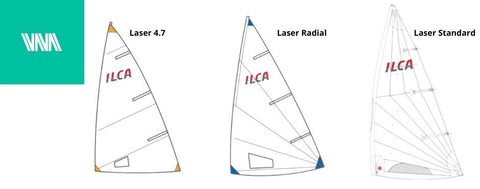
What is the new Laser Standard Sail design like?
In 2018, a new standard sail was ILCA approved which is referred to as ‘Mark II’ or ‘Mark 2’. There is no difference in size between the Mark I and Mark II however, the Mark 1 has horizontal cut panels compared to the Mark II which has radial cut panels. The Mark II sails also require Mark II battens rather then the Mark I battens . The Laser Class Association was determined to ensure the integrity and quality of the Mark I was not overshadowed by the new Mark II. They did this by creating the Mark II which focuses solely on durability. Therefore, the main difference between the two sails is durability. Clive Humphris, the ILCA Technical Officer is quoted in the class magazine as saying "The main objective of the design project for the Mark II was to create a sail with equal performance to the existing sail, but with better durability. We worked very hard to ensure that the Mark II was not a faster sail and wouldn't make all the existing sails obsolete overnight. The original Laser standard sail will continue to be available through authorized Laser dealers and we fully expect to see the two designs racing side-by-side for a number of years."
The new Mark II sail is made from a heavier cloth from 3.8 to 4.5 dacron material. There has been a change in the reinforcement patches which increases durability and maintains a better sail shape when under pressure. The window is noticeably bigger, as well as improved tapered battens with velcro batten pockets. The mast sleeve has been improved which reduces the amount of creases along the sail. The Laser Class Association successfully created a newer model sail for the Laser Radial without hampering the one design class which focuses on the condition of the boat, not the additional moving parts that can cause a substantial benefit to your racing.
What sail is best suited for me?
There are three types of Laser sails, Official Class Legal Sails, Class Compliant Sails and Training Sails.
Official Class Legal Sails - These sails are class compliant and are required for International and National events. There is a red button on these sails demonstrating that the supplier LaserPerformance has paid a contribution to the Laser class association. This allows them to be considered ILCA approved. These sails have 6 sail numbers on both sides with the first two numbers being red and the latter 4 coloured black.
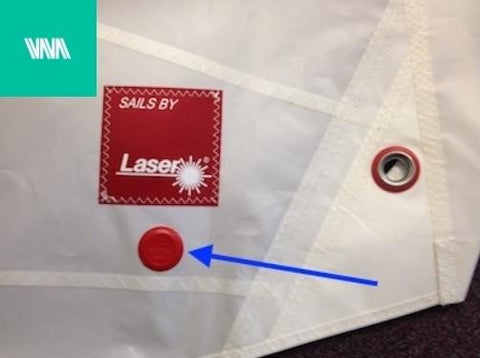
Class Compliant Sails - These sails are ideal for training camps or non class events. They are a higher standard than a training sail which provides a good basis for training and events with lesser importance. This sail has 6 sail numbers on both sides with the first two numbers being red and the latter 4 coloured black.
Training sails - These sails are made from a thinner material which reflect the cheaper price. They are ideal for sailors that are starting out and need a sail to compete in club races and training. This sail has 6 sail numbers on both sides with the first two numbers being red and the latter 4 coloured black.
Leave a comment
Please note, comments must be approved before they are published
- 1.1.1 Check The Weather
- 1.1.2 Pack Your Gear
- 1.2.1 Detach the Trailer/Dolly
- 1.2.2 Unpack Gear and Check
- 1.2.3 Start Rigging Your Laser
- 1.2.4 Attach the Rudder & Tiller
- 1.2.5 Tidy Up
- 1.2.6 Launching Your Dinghy
- 2 Laser Sailing Dinghy De-rigging
- 3 More Information
Before you head out on the water laser sailing, you have to rig your dinghy, and if you have never done this before, it may seem a little overwhelming.
There is no real order in which you should rig your Laser sailboat. There are many combinations and ways of rigging a laser sailboat, and that shown below is simply one combination. Talk to a few people as you rig up, have a few goes yourself, and you’ll work out which way works best for you.
It’s always good to rig up a few times at home before you head out laser sailing if it’s practical and safe to do so. This is recommended so that you are confident that you know what goes where, and so that you can remember how you tie the knots .
Rigging a Laser Sailboat Steps
As mentioned, there are many different ways when rigging a Laser sailboat. Below is 1 suggestion of the rigging sequence…
Before You Leave Home
Check the weather.
Check the forecast before you leave home, and look outside to check for yourself. Safety should be your first priority, so if the conditions are not suitable for your level of experience, then you may want to reconsider heading out.
Pack Your Gear
If you have been out sailing before, it’s a good idea to pack all your gear away neatly so that it is easy to find, This means that when you pack all your gear to head out sailing the next time, you will know where everything is and you won’t forget anything.
There is nothing worse than getting down to the waterfront and then start to rig your laser sailboat only to find that you have forgotten something crucial (eg. your sail or life jacket), and have to head home before you have made it out onto the water.
It’s easy to get excited about heading out for a great day on the water. However, before you leave, take a minute to check that you have everything packed.
When You Arrive At The Waterfront
Detach the trailer/dolly.
If the trailer has to be detached from the car when parked, do this 1st. Then slide the dolly/trolley off the trailer, and position it relatively close to where you will launch, with the bow pointing into the wind.

Unpack Gear and Check
Unpack all your other laser sailing gear , including sail, ropes, foils, and spars , and lay it out to make sure it is all there.
Some people like to get dressed in their sailing gear before they start rigging their boat. If you get dressed at the start, then as soon as you have finished rigging, you can hit the water immediately. It also means that your sail won’t flog as much and cause any extra wear and tear and that your boat won’t accidentally tip over while on the dolly… which may happen especially if there is quite a strong breeze blowing.
Start Rigging Your Laser
Lay the boom on the deck. Feed the mainsheet rope through the blocks and eyelet on the boom, and through the block in the cockpit and the traveler .
It is advisable to tie a figure 8 knot in both ends of the mainsheet rope so that it doesn’t pull through when out on the water. At the boom end, this is so that the mainsheet can be pulled fully on so that it is in the block-to-block position. At the other end so that it doesn’t pull through the mainsheet block in the center of the cockpit.
Leave it loose and un-cleated. Feed the outhaul rope along the boom also.

Next to the hull, lay the sail out and install the battens. Connect the 2 mast sections, and feed it up through the mast sleeve in the sail, making sure the boom spigot is in line with the sail.
Also be careful to ensure that there is no mud or dirt on the bottom of the mast (this may over time cause abrasion between the bottom of the mast and the mast step, which may eventually compromise the integrity of the hull).

Ensuring there are no overhead obstructions (including power lines), from the bottom ½ of the mast, lift it up almost vertical (slightly leaning into the breeze may make it easier to handle), and slot it gently into the mast step hole. This may prove to be a little awkward, so obtain assistance if required

With the mast in place, slot the boom into the mast, and tie off the outhaul to the sail clew using a bowline, as shown in the knots section. Then attach the clew tie-down , making sure to tie it underneath the outhaul.

Attach the vang and cunningham . Tie a small loop in the end of the cunningham and feed the end of the vang pin through it. This will keep the eye of the cunningham down low near the deck, stopping it from riding up (see photo below). Then feed the cunningham through the 2 eyelets in the rope itself, then down to the eyelet on the deck, and run it back to the cleat in the cockpit. Tie a bowline in the end for easy gripping when on the water.
A knot ( bowline or figure 8 knot ) in the end of the cunningham is essential, as it is the only thing preventing the rig from becoming completely detached from the hull when capsized.

Attach the Rudder & Tiller
Attach the rudder , making sure that the lift stop clicks into place, and leave it in the fully up position. Insert the tiller and fasten the retaining pin, ensuring that the tiller is underneath the traveler.
Lay the centerboard on the deck. Put in the drain plug in the stern of the hull.

With the mainsheet eased right out, the boat should sit quite contently while you tidy up your gear, sail bag, etc. However, if there is a breeze, be careful that your dinghy will not tip over while it is on the dolly, or that the boom will swing around and hit someone.
If it is windy, this is probably not the best time to be going out for a sail if you are a beginner.
If you are not already dressed in your wetsuit, rash vest , life jacket, hat , sunscreen , glasses, shoes , etc, now is the time to do so. It’s a good idea to get someone to keep an eye on your boat and laser sailing gear if you have to go to the change rooms.
Launching Your Dinghy
With the mainsheet eased, carefully wheel the dolly around, down the ramp, and into the water. Keep the laser sailboat pointing into the wind as much as possible, however as long as the mainsheet is eased you should be able to manage ok as long as the wind is less than 90° to the hull. If possible, do not allow the wind to exceed 90° to the hull.
Wheel the laser dolly into the water until it is fully submerged, and float the boat off the dolly. If you are on your own you may have to run the boat up onto the beach so that you can pull the dolly back out of the water (be careful not to damage the drain plug on the bottom of the hull, or the hull itself). Otherwise, get someone to pull your dolly out for you.
With the boat pointing into the breeze, slide the centerboard into the fin case so that it is most of the way up, but low enough so that the boom clears the fin when it swings around. Run the elastic retaining strap up to the eyelet at the bow and back to the centerboard or mast (the tension in the elastic creates friction so that the centerboard will remain in place when capsized ).
If you are in deep enough water, you will be able to push the rudder down or pull the rope attached to the rudder head, to rotate the rudder to its fully down position. If this can’t be achieved, then you may have to wait until you push the boat into deeper water to do this. Once the rudder is down, tie off the line, and make sure that you do not hit it on the bottom. Take every precaution to protect your foils.
Now, you’re ready for your 1st sail .
Laser Sailing Dinghy De-rigging
When de-rigging, simply reverse the order of the above steps.
If possible thoroughly wash all your gear in fresh water and dry all your gear before storage.
Also take care when folding the laser sail to not create a crease in the sail window, as it will weaken and eventually crack.

More Information
As mentioned, there are many different ways of rigging a Laser sailboat. Some have to do with personal preference of rigging order. Some differences also have to do with different types of gear and sailing accessories that you may have (eg. turbo kit, wind instruments, etc). We can’t cover every possible scenario here, so just have a go and see what works for you.
Also, make sure to check out the video below which talks some more about rigging a Laser sailboat, and enjoy your laser sailing :)
Previous: Sailing Knots
Next: Your First Sail
In the Laser cunningham and vang photo there appears to be extra ropes attached for the outhaul could you please describe what was done to achieve that
Hi Kyle The outhaul is a separate rope that runs from the clew of the mainsail up and around the mast and through a cleet to lock it off at the desired tension. It is separate from the cunningham and vang. You can see more about it here . I hope that this helps to answer your question. If not, let me know. cheers
Leave a Comment Cancel Reply
High School and College Sailors - 15% Off Apparel & Accessories - LEARN MORE

- Call Us +1-503-285-5536
- Sign in & Register
- Recently Viewed
Restoring & Upgrading Laser Sailboats - Advice & Common Questions

Over 200,000 Laser sailboats have been built over the last 40 years, more than most other small dinghy sailboats. In this article we are going to answer some of the common questions we receive about the basics of Laser sailboat rigging, how to tell what size rig you have, what you can upgrade, and more. This information is designed for the recreational sailor who is simply looking to replace missing parts or install simple upgrades that make it easier to enjoy their boat.
As a note, we're going to make frequent reference to a rigging manual put together by Vanguard Sailboats about 10 years ago. We still refer to this guide often as it shows two different styles of rigging side by side, which is particularly helpful if you have an older boat you wish to upgrade.
You can view that rigging guide here: Laser Rigging Guide (opens in new tab)
What size rig do I have? Standard vs. Radial vs 4.7 Explained
The Laser sailboat has had a number of different rig sizes, with the intention of making the boat sailable by a wide range of sailors (and different sailor weights) by simply swapping out the lower mast section and sail while keeping all other components the same. There are currently three different rig sizes and they are commonly referred to as 'Standard', 'Radial' and '4.7'. Below you will find an image that shows the three rigs side by side, and in the following section we'll explain each one.

Laser Standard / MK2 / ILCA 7
This is the most common Laser rig size, and the original rig on the boat when it was designed. It features a 7.06 square meter sail (about 76 square feet). In 2018, the Laser Class approved a new 'Standard' sail, which is referred to as the 'MKII' or 'Mark 2' to distinguish it from the first version. The difference, among other things, is in the panels. The original 'Standard' sail featured horizontal cut panels. The new MkII sail has radial cut panels. There is no difference in size between these two versions, and as of 2020 all new Laser Standard sails are available in this updated cut.

How to tell if you have a 'Standard' sail: The first and most obvious way to tell if you have a 'Standard' sail is to look at the panels. If they are horizontal, it is most likely a standard sail. Next, you can measure the luff (the front edge of the sail along the mast sleeve). This measurement should be about 5130 mm or 200 inches from the top of the sail to the bottom.
How to tell if you have a 'Standard' lower mast section: The 'Standard' lower mast section should measure about 2865 mm or 113 inches . It is a fairly stout mast section compared to the two smaller mast sections.
Laser Radial / ILCA 6
Originally called the 'M' rig when first designed, the Laser 'Radial' sail is smaller than the 'Standard' sail at 5.76 square meters (62 square feet). At the time, it was the only Laser sail to feature the radial cut panels, which allowed the sail to be de-powered more easily in bigh winds. Per the notes about the 'Standard' rig above, both the Standard and Radial sail feature the radial cut design. Another typical indicator of a Radial size sail are the blue panels at the tack and clew of the sail.
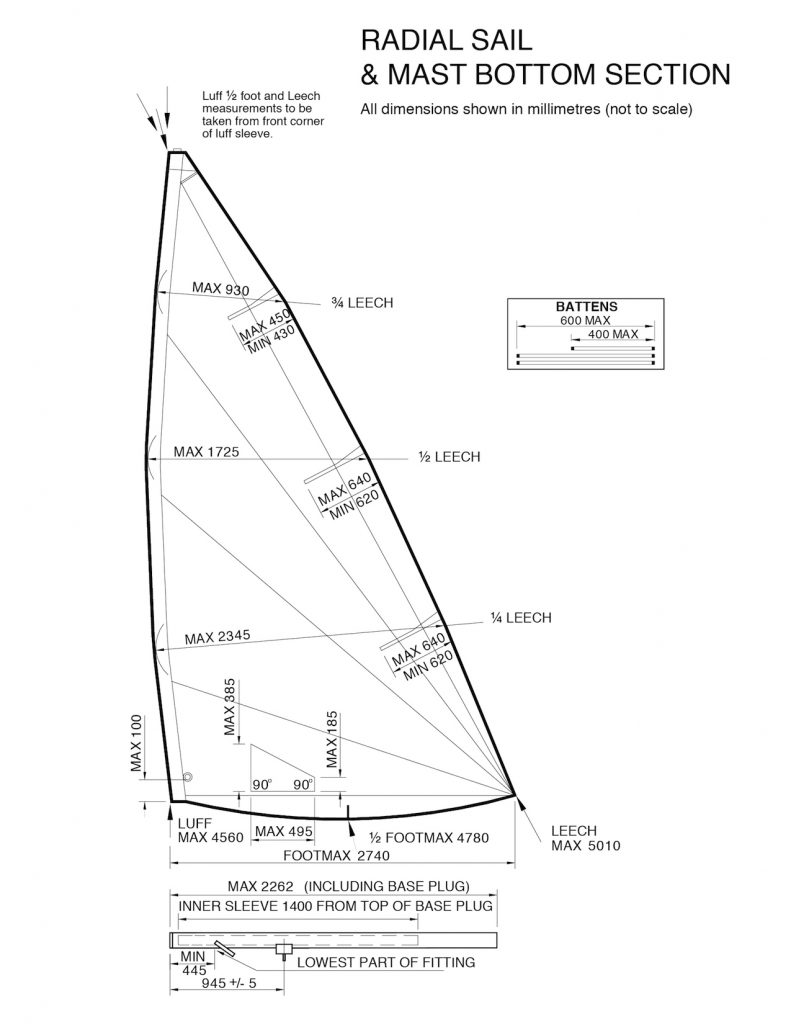
How to tell if you have a 'Radial' sail: The first and most obvious way to tell if you have a 'Standard' sail is to look at the panels. If they are radial, as in emanating out from the center, it is most likely a radial sail. Next, you can measure the luff (the front edge of the sail along the mast sleeve). This measurement should be about 4560 mm or 180 inches from the top of the sail to the bottom.
How to tell if you have a 'Radial' lower mast section: The 'Radial' lower mast section should measure about 2262 mm or 89 inches . It is also a bit smaller in diameter than the standard section.
Laser 4.7 / ILCA 5
The Laser 4.7 (or ILCA 5) is the smallest of the three Laser sails and was designed for young sailors just getting into Laser sailing. The 4.7 lower mast section is also different from the others in that is has a pre-bend near the boom fitting, allowing the sail to depower much easier. This is the least common Laser sail size, and if you have an old one around, chances are it is not a 4.7 sail.

How to tell if you have a '4.7' sail: The 4.7 is similar to the old 'Standard' sail as it has cross cut panels. Many 4.7 sails also have an obvious 4.7 logo somewhere on the cloth. Next, you can measure the luff (the front edge of the sail along the mast sleeve). This measurement should be about 4080 mm or 160 inches from the top of the sail to the bottom.
How to tell if you have a '4.7' lower mast section: The '4.7 lower mast section has a pre-bend in it and should measure about 1810 mm or 71 inches . The bend is the easiest way to tell it apart from the others.
What is the difference between 'Race' and 'Rec' rigging?
Up until about 20 years ago, the Laser featured very basic boom vang, outhaul, and cunningham controls. These were basically just long lengths of line with a series of loops and knots designed to create 'purchase' or pulling power to help tighten the controls and further shape the sail. In many ways, these rudimentary controls limited the type of sailor who really excelled in terms of performance, as you needed to be very strong and athletic to control the boat (you still do at the very top of the racing scene, particularly if you hope to compete in the Olympics). If you have a 30+ year old boat that hasn't been updated, chances are it is a 'rec' rigged boat. There is no problem sailing a Laser like this and many sailors enjoy the simplicity of the rigging and low cost of replacing line and parts.
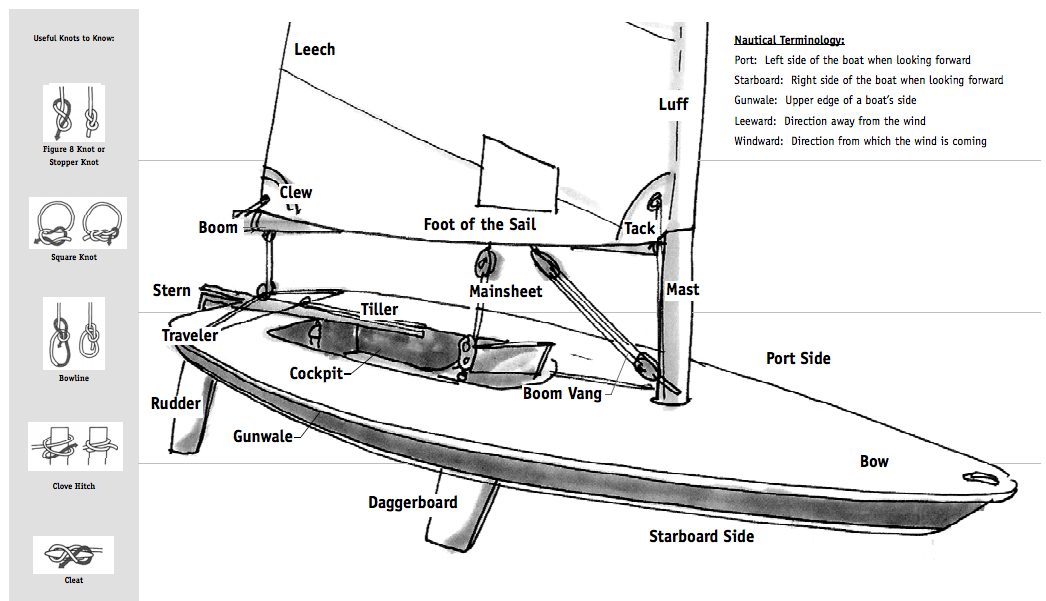
In 2000/2001, a new set of controls was approved, designed to make it easier to manipulate the sail (particularly for lighter sailors) and to rig/unrig the boat. These included a 15:1 boom vang, 8:1 cunningham, and 6:1 outhaul system. What was introduced at this time was and is still referred to as the 'Race' or 'Pro' set up, as opposed to the 'Recreational' or 'Standard' set up found before 2000. Between 2000 and 2010, many active Laser sailors upgraded their existing boats to this new standard with a series of kits (these are still available) and new boats started to include them. Starting in 2008/2009, basically every new Laser sailboat included some version of this upgraded Race rig set up. Lets take a look at how to quickly tell if your current boat is set up as a 'Race' or 'Rec' boat and then some of the differences between the two set ups.
Deck Hardware: Differences Between Race & Rec
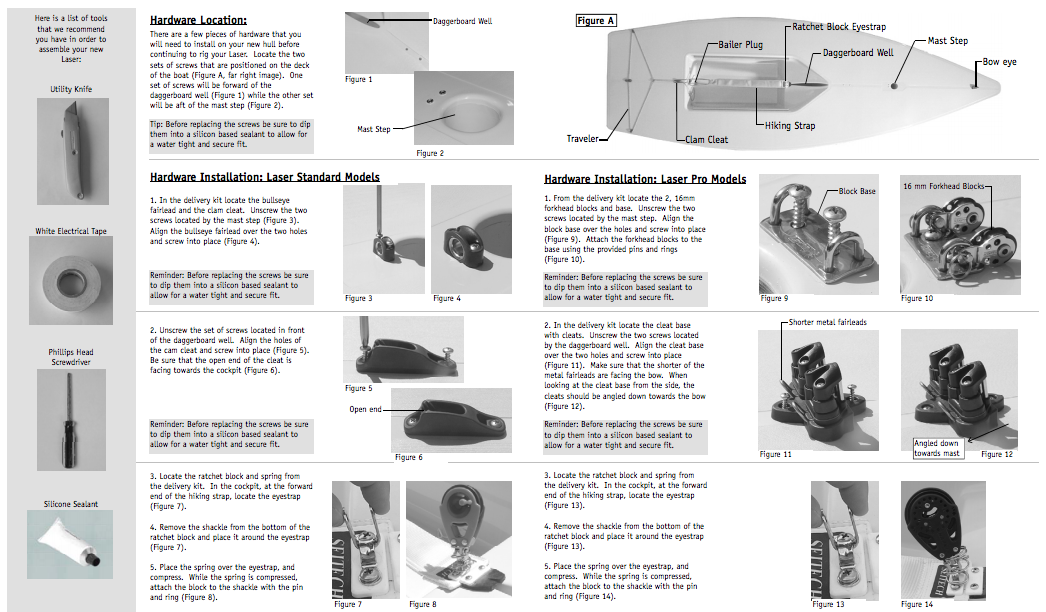
The most common question we get is how do I tell if my boat is set up with Race or Rec equipment? The quickest way to find out is to look at the hardware mounted on the deck of your Laser. Refer to the image above.
The 'Rec' setup (or 'Standard') is shown on the left , and the 'Race' set up (or 'Pro') is shown on the right. The Rec set up features a single bullseye fairlead just aft of the mast step and a single clam cleat just forward of the daggerboard trunk. These two pieces of hardware are for the cunningham control line.
The 'Race' setup (or 'Pro') is shown on the right , and features more advanced hardware. This hardware includes a deck plate with blocks just aft of the mast step (replaces the single fairlead) and a dual deck cleat in place of the single clam cleat. This new system allows both the cunningham and outhaul line to be lead down the mast and back to the cockpit for easy cleat/uncleat and adjustment from the new deck cleat system.
Insider Tip: Upgrade to 'Race' Rigging with just two kits! Back in 2000, Laser builders knew that sailors with existing boats would want a way to quickly upgrade from the 'Rec'/'Standard' rigging to the upgraded 'Race' rigging. For this reason, we still offer two kits just for this purpose.
- Laser Outhaul / Cunningham Upgrade - This kit includes everything from the blocks, cleats, hardware, line, blocks and instructions to fully update an older Laser to the latest outhaul and cunningham controls. This is the easiest way to upgrade your boat, though you will need a few basic tools to remove the old hardware from the deck and install the new components. In terms of an upgrade, this is one of THE BEST you can do to make your Laser easier to sail and to control in strong breeze.
- Laser Vang Upgrade - Upgrade to the latest 15:1 vang, no tools required! This vang system connects the same way as your old one (with a pin at the tang on the mast and with a 'key' to the fitting on the boom) and can be ready to go in minutes.
Deck Hardware: Shared Components Between Race & Rec
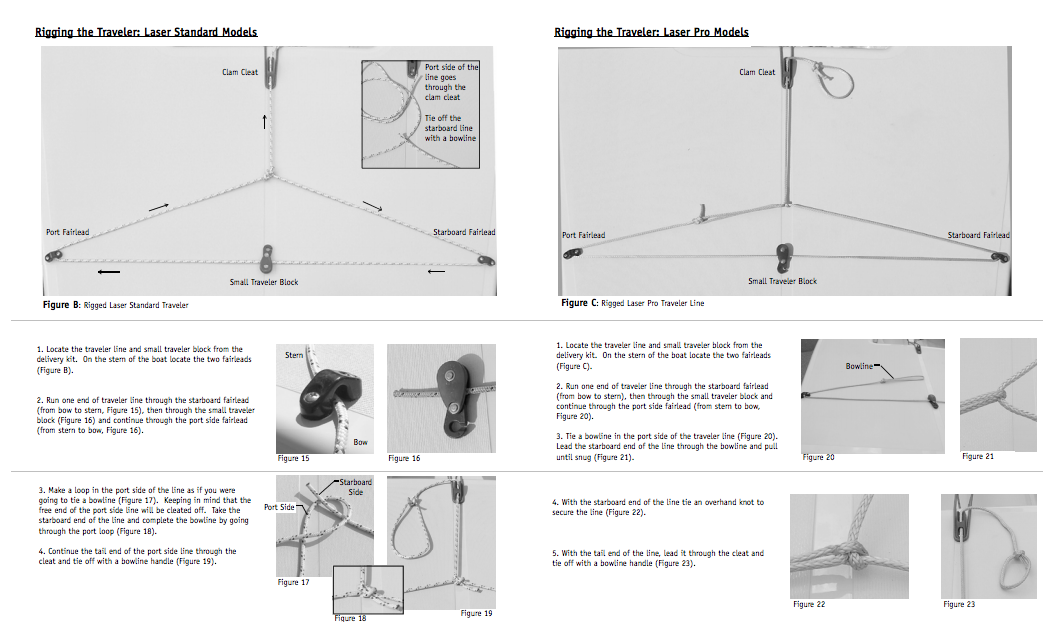
The rest of the hardware on a Laser deck is the same, regardless of what rigging specification you use. The image above shows the traveler set up, which consists of two fairleads mounted on the back corners of the boat and a single cleat mounted just aft of the cockpit on the deck. There are a few components to this area we'll mention here for your reference:
- Fairleads - Depending on the year of your Laser, you'll need either a 23mm Fairlead (found on most older boats ) or a 26mm Fairlead . We also have replica versions of both the 23mm and 26mm fairleads.
- Cleat - A single aluminum clam cleat is used for cleating the traveler. We recommend the CL221 Cleat .
- Traveler - We recommend 11 feet of a low stretch line. You can also purchase our premium Vectran Traveler with has a nicely spliced eye on one end.
Mainsheet System & Blocks
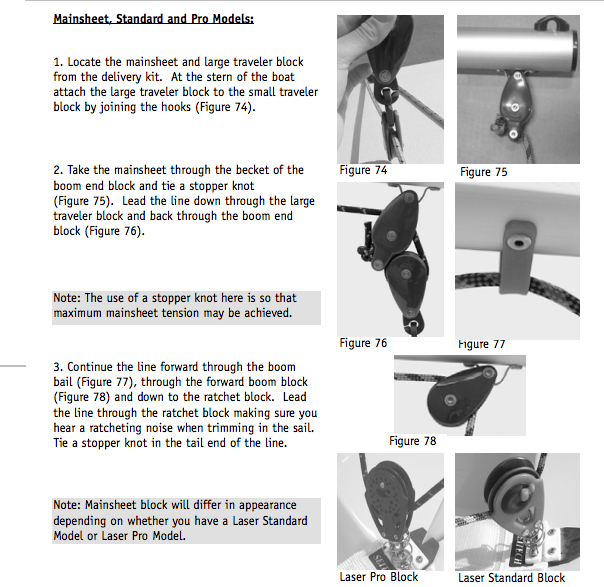
Regardless of specific rig set up, the Laser mainsheet is rigged the exact same way. The mainsheet system includes a ratchet block attached to the deck just forward of the cockpit, two blocks mounted on the boom, and a set of traveler blocks at the rear on the deck. There are a few different components and some upgrades we'll reference here.
- Mainsheet Ratchet Block - You can use any ratchet block here that is designed for a 6-8 mm line (the desired range of diameter for a Laser mainsheet). We recommend:
- Harken 57mm Ratchet Block
- Ronstan 55mm Orbit Block
- Mainsheet Spring
- Eyestrap (Stainless)
Boom Vang: 15:1 Race Vang vs 3:1 Rec Vang

The Laser boom vang is a series of blocks and line that connect to the boom with a key style fitting for quick removal and to a tang fitting with a pin at the base of the mast just above the deck line.
- Rec Vang (3:1) - Sometimes called the classic vang, this is a simple '3:1' purchase vang system with two blocks and a length of line. Here are the components.
- Classic Vang Block Upper
- Classic Vang Block Lower
- Classic Vang Assembly
- Classic Vang Line
- Race Vang (15:1) - Sometimes called the pro vang, this is a more powerful '15:1' purchase vang system with more turning points. It uses both a covered control line and pure dyneema/spectra line for strength. This is available as a full upgrade kit in a few different versions for easy install to your Laser. It is easier to install than the Outhaul/Cunningham kit as there are is no deck hardware to install - simply clip in the same way as your old vang.
- Harken Laser Vang Upgrade
- Vang Becket Block - Used at the top of the Harken Vang assembly
- Practice Vang Upgrade (Generic)
- Shared Components - There are a few pieces of hardware used on the boat regardless of what vang you have.
- Laser Vang Tang - Attached to lower mast section for connecting lower part of vang to mast
- Laser Vang Strap - Attached to boom for connecting top part of vang to mast with the key fitting via the slot
Outhaul Control System

The outhaul controls the back corner, or the clew, of the sail. The 'rec' / classic rigging is quite simple, whereas the 'race' rigging adds more power to the sail control, making it easier to adjust and flatten the sail to depower in heavy wind.
- Rec Outhaul - Uses a 10 foot length of line and the clam cleat on the boom to achieve a basic purchase system for tightening the sail. The entire control exists right on the boom.
- Race Outhaul - The upgraded race outhaul system has a few variants, but adds twice as many turning points for a more power purchase system. It uses two sections of line, a primary dyneema or spectra line in the rear and a secondary covered line in the front, which is lead down to the deck cleat for easy adjustment.
- Harken Outhaul/Cunningham Kit - Includes everything, down to the deck hardware, for adding the upgraded Outhual and Cunningham set up to your existing Laser.
- Practice Outhaul/Cunningham Kit - A less expensive alternative to the Harken kit from Allen.
Cunningham (Downhaul) Control System
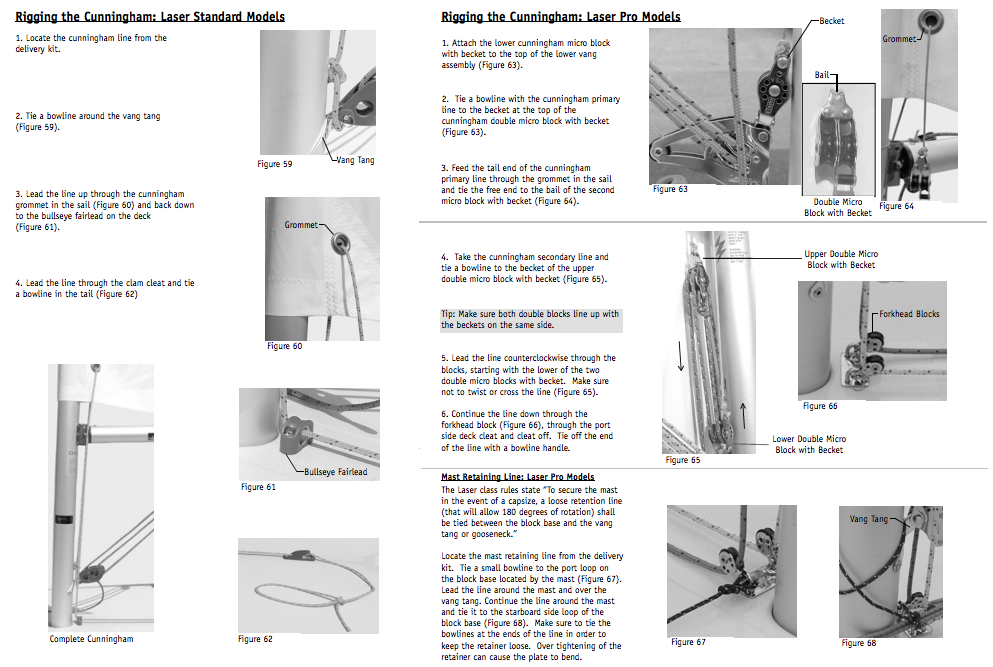
The cunningham, sometimes called the downhaul, controls the front edge of the sail The 'rec' / classic rigging is quite simple, whereas the 'race' rigging adds more power to the sail control, making it easier to adjust and flatten the sail to depower in heavy wind.
- Rec Outhaul - Uses a 10 foot length of line and the single clam cleat on the deck. The line is tied around the vang tang, up through the tack grommet, down to the fairlead, and back to the clam cleat for adjustment.
- Race Outhaul - The upgraded race cunningham system also has a few variants, but creates a powerful 8:1 purchase system. It uses two sections of line, a primary dyneema or spectra line to pass through the tack grommet and a coverer secondary line which is fed through the blocks and lead down to the deck cleat for easy adjustment.
- Harken Outhaul/Cunningham Kit - Includes everything, down to the deck hardware, for adding the upgraded Outhual and Cunningham set up to your existing Laser.
- Practice Outhaul/Cunningham Kit - A less expensive alternative to the Harken kit from Allen.
Subscribe To Our Newsletter
Sign up for our newsletter to receive exclusive discounts, new product announcements, and upcoming sales.
Laser 2 Sailboat: The Ultimate Guide to Mastering this High-Performance Racing Dinghy
by Emma Sullivan | Jul 20, 2023 | Sailboat Gear and Equipment

Short answer laser 2 sailboat:
The Laser 2 sailboat is a high-performance sailing dinghy designed for racing and recreational sailing. It features a single trapeze, a mainsail, and a jib, providing exciting and responsive sailing experiences. Its hull is made from fiberglass, making it durable and lightweight.
Introduction to the Laser 2 Sailboat: Experience the Thrill of Sailing with this Classic Vessel
Have you ever dreamed of harnessing the power of the wind and gliding across the open waters? If so, then the Laser 2 Sailboat is just what you need to make those dreams a reality. With its sleek design, nimble handling, and unparalleled performance, this classic vessel has been a favorite among sailing enthusiasts for decades.
The Laser 2 Sailboat is renowned for its ability to thrill both beginners and experienced sailors alike. Whether you’re looking to learn the ropes or test your skills in competitive racing, this versatile boat is up to the task. Its simple rigging system and responsive controls make it easy to handle, even for novices. And with its durable construction and steady buoyancy, it can withstand any conditions Mother Nature throws at it.
One of the most captivating aspects of the Laser 2 Sailboat is its incredible speed. Once you catch a gust of wind in its fully battened sail, you’ll feel an exhilarating rush as you slice through the water like a knife. The combination of its lightweight hull and powerful sail allows for impressive acceleration and top speeds that will leave other boats trailing behind. It’s no wonder why sailors around the world have fallen head over heels in love with this legendary vessel.
But don’t be fooled by its fast-paced nature – the Laser 2 Sailboat also offers plenty of opportunities for leisurely cruising and exploration. Its spacious cockpit can comfortably accommodate two or three people, making it perfect for adventurous outings with friends or family members. Take a lazy afternoon sail along picturesque coastlines or navigate tranquil lakes while enjoying breathtaking views – there’s no limit to where this magnificent vessel can take you.
What truly sets apart the Laser 2 Sailboat from other sailboats is its community. Joining fellow sailors who share your passion for adventure and camaraderie makes every sailing experience all the more enjoyable. Connect with experienced professionals who can offer valuable tips on technique, equipment, and maintenance. Engage in spirited discussions about your latest sailing adventures or upcoming regattas. With the Laser 2 Sailboat, you’ll become part of a tight-knit group that spans the globe, bound together by a love for this remarkable vessel.
So, if you’re ready to embark on an unforgettable sailing journey, look no further than the Laser 2 Sailboat. Experience the sheer thrill of harnessing the power of wind with its unmatched performance and speed. Immerse yourself in a vibrant community of like-minded sailors who will inspire and support you along the way. Get ready to create memories that will last a lifetime – because once you’ve experienced sailing with this classic vessel, there’s no turning back.
How to Master the Art of Sailing a Laser 2 Sailboat: A Step-by-Step Guide for Beginners
Sailing is an ancient art that has captivated humans for centuries, invoking a sense of freedom, adventure, and pure bliss. If you’ve ever daydreamed about gliding effortlessly across the water with the wind in your hair, then learning how to sail a Laser 2 sailboat might be the perfect endeavor for you. In this step-by-step guide tailored specifically for beginners, we will explore the intricacies of sailing a Laser 2 and offer tips to help you master this exhilarating hobby.
Step 1: Understanding the Basics Before setting foot on a Laser 2 sailboat, it’s crucial to grasp the fundamental concepts of sailing. Familiarize yourself with key terms such as “tacking” (changing direction against the wind), “jibing” (changing direction with the wind behind you), and “points of sail” (different angles at which a boat can travel relative to the wind). Learning these essentials will serve as your foundation in becoming a skilled sailor.
Step 2: Preparing Your Laser 2 Sailboat Once you’ve familiarized yourself with sailing’s terminology, it’s time to prep your vessel. Ensure that all necessary equipment is on board and properly functioning- from ropes and rigging to sails and rudders. A well-maintained boat guarantees a smoother sail and contributes significantly to overall performance.
Step 3: Rigging Your Boat Rigging refers to setting up your boat, including attaching sails and rigging ropes correctly. This process can seem daunting at first but fear not! It becomes second nature with practice. Pay close attention to maintaining proper tension in your rigging lines – too loose or too tight can impact maneuverability considerably.
Step 4: Launching Your Laser 2 Sailboat You’re now ready for launch! Identify a safe location with suitable access points for entering the water; preferable areas would have few obstructions like rocks or shallow waters. Be mindful of wind conditions and direction before venturing out to ensure a more enjoyable experience – light to moderate winds are ideal for beginners.
Step 5: Safety First Never underestimate the importance of safety during any sailing activity. Before setting sail, equip yourself with a personal flotation device (PFD) and ensure everyone on board does the same. Also, be aware of weather forecasts and water currents that can affect your journey. Remember, wise sailors prioritize safety above all else.
Step 6: Balancing Act Mastering balance is vital when sailing a Laser 2 sailboat as shifts in body weight greatly impact agility and speed. Finding your center of gravity as you maneuver, particularly during turns or gusts of wind, will optimize your boat’s performance. Train your mind and body to anticipate these changes; it is both an art and a science.
Step 7: Navigating the Wind Understanding the nuances of wind direction is key to becoming an accomplished sailor. Study how sails behave when catching the wind at different angles, known as points of sail mentioned earlier. Adjusting the angle between the sail’s edge and the wind will allow you to harness its power efficiently while simultaneously controlling your course.
Step 8: Mastering Tacking and Jibing Now comes the exciting part – changing directions! Tacking refers to turning into the wind by bringing the bow through it; jibing involves turning away from the wind with it behind you. These maneuvers require practice, timing, and coordination between crew members (if applicable). As you become more proficient in tacking and jibing smoothly, you’ll experience newfound confidence in maneuverability.
Step 9: Advanced Skills & Techniques Congratulations! You’ve grasped the basics and are now ready to delve into more advanced techniques such as fine-tuning sail trim (adjustment), mastering upwind sailing angles, or even attempting tricks like planing (sailing at high speed with hull lifting out of the water). These skills come with time and experience, so continue pushing your boundaries as you evolve in your sailing journey.
Step 10: Continued Learning Sailing is an art that can never be fully mastered. The beauty lies in continuous learning, honing your skills, and embracing new challenges. Join sailing clubs or communities to exchange knowledge and experiences with fellow enthusiasts. Embrace the lifelong process of understanding wind patterns, experimenting with sail configurations, and exploring different bodies of water. Be open to new discoveries!
In conclusion, mastering the art of sailing a Laser 2 sailboat requires patience, dedication, and enthusiasm. With this step-by-step guide for beginners as your compass, set sail on a transformative journey that will unlock a world of adventure and sheer joy out on the open waters. Let the wind carry you toward newfound horizons as you become one with nature through the sport of sailing!
Frequently Asked Questions About the Laser 2 Sailboat: Everything You Need to Know
Title: Frequently Asked Questions About the Laser 2 Sailboat: Everything You Need to Know
Introduction: Ahoy, sailing enthusiasts! Whether you are new to sailing or a seasoned sailor, one boat that has undoubtedly caught your attention is the Laser 2 Sailboat. In this comprehensive guide, we will address some of the most commonly asked questions about this remarkable vessel. So grab your captain’s hat, secure your lifejacket, and let’s set sail into the world of the Laser 2!
1. What Makes the Laser 2 Sailboat So Special? The Laser 2 Sailboat stands out for its versatility and high-performance capabilities in both cruising and racing scenarios. The boat features an innovative design that combines speed and stability like no other. Its two-man configuration allows for collaboration between sailors while maneuvering through varied wind conditions, making it truly unique among its counterparts.
2. How Does It Differ from Other Sailboats? While there are many sailboats on the market, the Laser 2 sets itself apart through its adaptability. This vessel can be equipped with various rigging options according to your skill level or desired sailing style. From a single-sail setup for beginners to twin-trapeze configurations for advanced racers seeking an adrenaline rush – there is something for everyone!
3. Is It Beginner-Friendly? Absolutely! The Laser 2 caters to sailors of all expertise levels. Novice sailors can embark on their nautical adventures with confidence due to its forgiving nature and stable hull design. With accessible controls and simplified rigging systems, those new to sailing will find it easy to learn the ropes while still experiencing thrilling moments on the water.
4. How Do Its Racing Capabilities Compare with Other Boats? For competitive spirits hungry for victories on race day, the Laser 2 won’t disappoint! Its lightweight hull allows for quick acceleration, ensuring you consistently remain at the forefront of races against competitors. The boat’s maneuverability and responsive controls allows for quick adjustments, making it a fierce contender even in highly competitive fleets.
5. Can It Be Sailed Single-Handed? Yes, it can! Though designed as a two-person sailboat, the Laser 2 can be sailed solo by experienced sailors who prefer going solo or need some solitude on the water. With appropriate modifications and adjustments to the rigging systems, it is possible to enjoy the Laser 2 experience single-handedly.
6. What Type of Maintenance Does the Laser 2 Sailboat Require? The Laser 2 is known for its durability and low-maintenance requirements. Its robust construction ensures longevity, while simple systems make maintenance tasks hassle-free. Regular cleaning after each sail and occasional inspections of rigging components should suffice to keep your Laser 2 in top-notch condition for years of enjoyment.
7. Where Can I Find Spare Parts or Accessories? Fear not, fellow mariner! The Laser 2 community is strong, with passionate enthusiasts regularly sharing tips, tricks, and information about spare parts or accessories. Numerous online retailers specialize in providing genuine Laser 2 components to ensure you find exactly what you need with ease.
Conclusion: Now that we have delved into the world of frequently asked questions about the remarkable Laser 2 Sailboat, you are equipped with vital knowledge that will help you set sail confidently upon its sleek hull. Whether you’re seeking casual cruising adventures or craving exhilarating races, this versatile vessel has got your back covered. So cast off from land and embark on unforgettable aquatic expeditions aboard the magnificent Laser 2 – where thrill meets tranquility!
Exploring the Design and Features of the Laser 2 Sailboat: What Sets It Apart?
Introduction:
The Laser 2 sailboat is not your ordinary watercraft. It is a remarkable fusion of design, engineering, and ergonomics that sets it apart from other sailboats in the market. In this blog post, we will dive into the intricacies of its design and explore the array of features that make the Laser 2 a true standout.
1. Lightweight Construction:
One striking feature of the Laser 2 sailboat is its lightweight construction. Meticulously crafted using advanced materials and innovative manufacturing techniques, every component is designed to reduce weight without compromising on strength. This means increased durability while allowing for swift and nimble sailing performance.
2. High-performance Hull Design:
At the heart of the Laser 2’s exceptional functionality lies its masterfully designed hull. Utilizing extensive research and cutting-edge hydrodynamics, this boat glides through water with minimal resistance, maximizing both speed and maneuverability. Its sleek lines seamlessly integrate form with function, making it a sight to behold as it effortlessly slices through waves.
3. Three-sail Configuration:
Unlike conventional sailboats sporting a single or double-sail setup, the Laser 2 boasts a unique three-sail configuration that takes sailing to a whole new level. Consisting of a main sail, jib, and spinnaker, this trifecta offers enhanced control over various wind conditions. Whether you’re gracefully cruising along or chasing adrenaline-fueled speeds, this versatile setup ensures an exhilarating experience for sailors of all skill levels.
4. Ergonomic Cockpit Design:
The Laser 2’s cockpit design strikes an exquisite balance between comfort and functionality. The ergonomically contoured seating positions allow sailors to maintain optimal control while minimizing strain during long journeys or intense racing competitions. Every touchpoint has been meticulously engineered to keep sailors in harmony with their vessel – leading to enhanced responsiveness and precision handling on the water.
5. Rigging Simplicity:
Tying knots and setting up a sailboat can be a daunting task for newcomers. However, the Laser 2 eliminates this complexity by incorporating an intuitive rigging system. With numbered lines and user-friendly adjustments, even novice sailors can quickly learn to set up and fine-tune their sails. By reducing hassle and ensuring ease of use, the Laser 2 empowers sailors to focus on what truly matters – sailing itself.
6. Durability that Stands the Test of Time:
Investing in any watercraft is a significant decision — one that requires assurance of its longevity. The Laser 2’s robust construction ensures it stands the test of time, with high-quality materials and meticulous craftsmanship providing unmatched durability. This means you can confidently embark on countless adventures without worrying about wear and tear impacting your vessel’s performance or structural integrity.
Conclusion:
In conclusion, the Laser 2 sailboat undoubtedly surpasses expectations when it comes to design and features. Its lightweight construction, high-performance hull design, three-sail configuration, ergonomic cockpit, rigging simplicity, and durable build make it shine amidst a sea of ordinary sailboats. Whether you’re an experienced sailor seeking exhilarating thrill rides or a beginner looking to enter the world of sailing, the Laser 2 sets itself apart as a sophisticated watercraft that guarantees unforgettable experiences on every voyage.
Safety Tips and Precautions for Sailing a Laser 2 Sailboat: Enjoying Your Adventure Responsibly
Sailing a Laser 2 Sailboat can be an exhilarating experience, allowing you to explore the open waters and enjoy the serenity of the sea. However, just like any other water sport, it’s crucial to prioritize safety and take necessary precautions to ensure an enjoyable adventure. In this blog post, we will provide you with detailed professional advice on how to safely navigate your Laser 2 Sailboat while still having a witty and clever time!
1. Mind the Weather Forecast: Before setting sail, always check the weather forecast thoroughly. Wind speed, direction, and potential storms are critical factors that can greatly influence your sailing experience. While it may seem exciting to challenge yourself in rough conditions or strong winds, it’s essential to understand your abilities and limitations as a sailor. Remember, responsible sailors don’t disregard signs of inclement weather – they adjust their plans accordingly.
2. Get Comfortable with Your Boat: Knowing your boat inside out is paramount for safe sailing adventures. Take the time to familiarize yourself with every aspect of your Laser 2 Sailboat – from its rigging and sails to its navigation instruments and safety equipment. A witty sailor knows their boat intimately; better understanding ensures you’re prepared for any situation that comes your way.
3. Safety Equipment Should Be Your Best Friend: Never set sail without properly equipped safety gear! Life jackets are at the top of the list – make sure you have enough for each crew member aboard your Laser 2 Sailboat. Additionally, carry flares or alternative signaling devices in case you need help in an emergency situation — cleverly choose colorful flares that match your vibrant personality!
4. Communicate Effectively: Before embarking on your sailing journey, let someone else know about your plans. Share details including departure time, estimated return time, planned route (if applicable), and emergency contact information. Keeping friends or family informed allows them to keep an eye out for your well-being from the shore, and they’ll appreciate your responsible approach to adventuring.
5. Buddy System: Sailing is more enjoyable when you have company. Not only does sailing with a partner enhance your overall experience, but it also enhances safety. In case of an injury or other unforeseen circumstances, having a buddy on board ensures that there’s always someone available to assist or seek help if needed — plus, you can share witty banter during those long stretches of calm waters!
6. Keep Your Phone Dry: While it may seem obvious, we cannot stress enough how important it is to keep your phone protected from water damage. We live in a world where being connected is essential – not just for capturing clever Instagram stories but also for emergencies. Today’s smartphones are often equipped with waterproof or resistant features; however, carrying them in a proper waterproof case will provide an extra layer of protection – just in case things get too wet and wild!
7. Education is Key: Investing time in expanding your sailing knowledge through courses and certifications will undoubtedly make you a safer sailor. Understanding navigation rules, reading charts or maps, and knowing how to react in different boating situations are invaluable skills that come with education and training. Being professionally skilled while exhibiting a clever wit ensures admiration from fellow sailors!
8. Respect Nature: Finally, always respect the environment around you when sailing your Laser 2 Sailboat. Avoid littering, decrease noise pollution as much as possible (we know it can be difficult when celebrating witty victories on the high seas!), and follow guidelines for responsible anchoring practices.
In conclusion, enjoying sailing adventures responsibly means putting safety first while injecting some wit and charm into every voyage aboard your Laser 2 Sailboat! By following these tips and precautions diligently, you can confidently navigate the open waters while having fun, ensuring your adventure is memorable for all the right reasons. Happy sailing and stay cleverly safe!
Unleashing Your Competitiveness: Racing Techniques and Strategies in a Laser 2 Sailboat
Introduction: Sailing is a sport that has captured the hearts of adventurers and thrill-seekers since time immemorial. The sense of freedom, mastery over nature, and the adrenaline rush offered by sailing are unparalleled. Amongst all the sailboat classes out there, the Laser 2 is renowned for its exhilarating speed, maneuverability, and versatility. Whether you’re an experienced sailor or a novice looking to dive into competitive racing, this blog post will guide you through some ingenious techniques and strategies to unleash your competitiveness in a Laser 2 sailboat.
1. Mastering Boat Handling: A vital aspect of successful racing in a Laser 2 is mastering boat handling skills. This includes understanding how to efficiently maneuver your vessel through various wind conditions, waves, and currents. Being able to extract maximum speed from your sailboat while maintaining control requires finesse. Practice tacking (turning the bow of the boat through the wind) and jibing (turning the stern through the wind) until these maneuvers become second nature.
2. Effectively Using Sail Controls: Sail controls play a crucial role in optimizing your overall performance on water. Familiarize yourself with the main controls available on a Laser 2: mainsheet, traveler, vang/kicker, cunningham/downhaul, and outhaul; each has its own purpose in fine-tuning your sails’ shape and power efficiency. Understanding how to trim your sails using these controls can make a significant difference in speed and responsiveness.
3. Tactical Decision-Making: Racing involves not just raw sailing skills but also strategic decision-making on the racecourse. Analyze wind shifts meticulously to anticipate changes before they occur and position yourself advantageously on the course accordingly. Keep an eye on other competitors’ tactics as well; learn from their successes but also be ready to adapt and counter their moves. Sail smart, exploiting any tactical opportunity that arises to gain an edge over your rivals.
4. Teamwork: For those participating in two-person or three-person Laser 2 racing, effective teamwork is paramount. Communication between teammates on boat handling, sail setting adjustments, and tactical decisions need to be smooth and seamless. A synchronized effort between the helmsman and crew can make the difference between a win and a loss. Develop trust with your team members, learn each other’s strengths and weaknesses, and work in tandem towards a common goal.
5. Physical Fitness: Sailing may not seem like an intense physical activity at first glance, but maintaining optimal fitness levels is vital for competitive success in a Laser 2 sailboat race. Cardiovascular endurance helps you sustain high energy levels throughout demanding races, while strength training allows you to handle the boat’s forces efficiently during maneuvers. Core stability exercises are indispensable for maintaining balance on trapezing boats like the Laser 2.
Conclusion: Unleashing your competitiveness in a Laser 2 sailboat is a journey that combines technical mastery of boat handling, strategic decision-making, effective teamwork, and physical fitness. Investing time in honing these skills will undoubtedly elevate your racing game to new heights of excellence. So embrace the thrill of competition, embrace the adventure that comes with sailing a Laser 2, and prepare to unleash your full potential as you conquer the waves with style!
Recent Posts

- Sailboat Gear and Equipment
- Sailboat Lifestyle
- Sailboat Maintenance
- Sailboat Racing
- Sailboat Tips and Tricks
- Sailboat Types
- Sailing Adventures
- Sailing Destinations
- Sailing Safety
- Sailing Techniques

Laser now rules the waves around the world in over 50 countries. During that time LaserPerformance has been there supplying the most sought-after Lasers and supporting the growth of the Laser sailing community around the world. “There have been more than 200,000 Lasers built around the world, the biggest number of any boat ever. They are sailed at Olympic, Nationals, in Men, Women, Juniors and Masters levels and of course as a fun boat.”

The new Weekender (name of the first prototype), with “TGIF” (Thank God It’s Friday) on the sail, won the America’s Teacup regatta in Wisconsin.
The boat was named “Laser” in November 1970 and production started the same year. The Laser was launched at the New York Boat Show. Their uniform design and affordable price attracted sailors and 144 Lasers were sold. Laser sails were identical due to modern laser cutting thus setting a standard for future racing classes.
The name “Laser” was chosen as being modern, recognisable and truly international and that the symmetrical Laser beam logo would only have to go on one side of the sail.
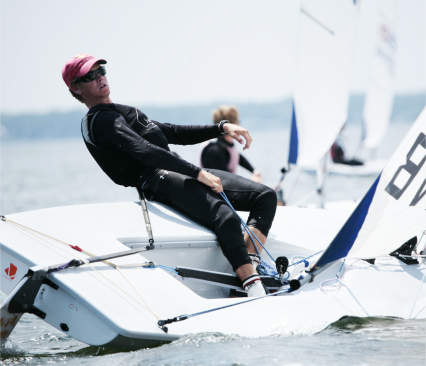
The Radial Rig
In the 1980s the smaller Laser Radial rig was designed by LaserPerformance allowing smaller sailors to sail with less effort. The Laser Radial quickly became popular amongst women sailors and others around the world.
The 4.7 Rig
Following the success of the Radial, LaserPerformance developed the Laser 4.7 rig in the UK in 1989 with an aim of allowing youth sailors to enjoy the Laser
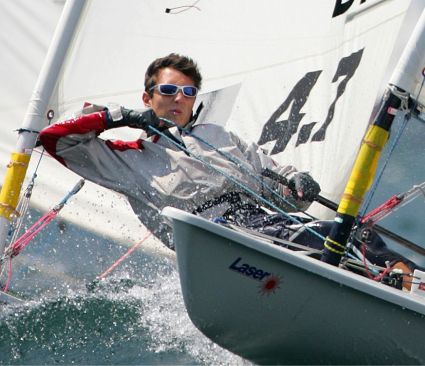
LaserPerformance steered the path to the Olympics winning entry for the 1996 Olympics in Atlanta.
The Laser was introduced to the Olympics as an open class for the 1996 Quadrennial. The simple single-person dinghy already had a cult following of thousands all over the world and inclusion in the Olympics was viewed as a forgone conclusion.
The first ever Olympic medal in the Laser was won by Brazil's Robert Scheidt at the Atlanta 1996 Games after a dramatic start line duel with British rival Ben Ainslie.
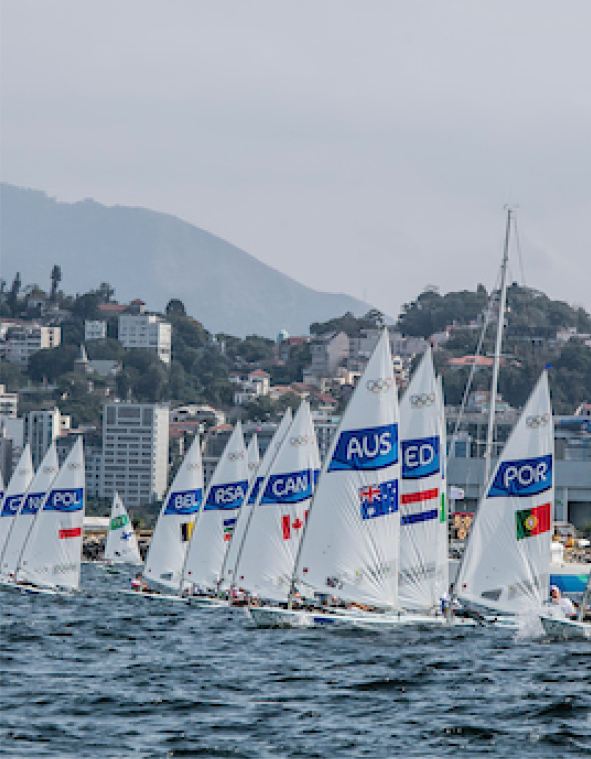
OLYMPICS: 1996 ATLANTA :: 2000 SYDNEY :: 2004 ATHENS :: 2008 BEIJING :: 2012 LONDON :: 2016 RIO DE JANEIRO :: 2020 - (2021) TOKYO
Xu Lijia is the first Chinese sailor to receive a bronze medal in women's Laser Radial class at the 2008 Summer Olympics in Beijing and a gold medal in the same event at the 2012 Summer Olympics in London. Her win led to a surge in popularity in the sport of sailing in China.
46 countries participated in Laser competition at the 2016 Olympics in Rio, reaffirming the Laser’s global popularity.
The Laser's low cost and ease of transportation means it has the widest pool of nations competing of any Olympic Sailing Class and it's not unusual to see sailors from nations that aren't traditionally viewed as big sailing nations on the podium.
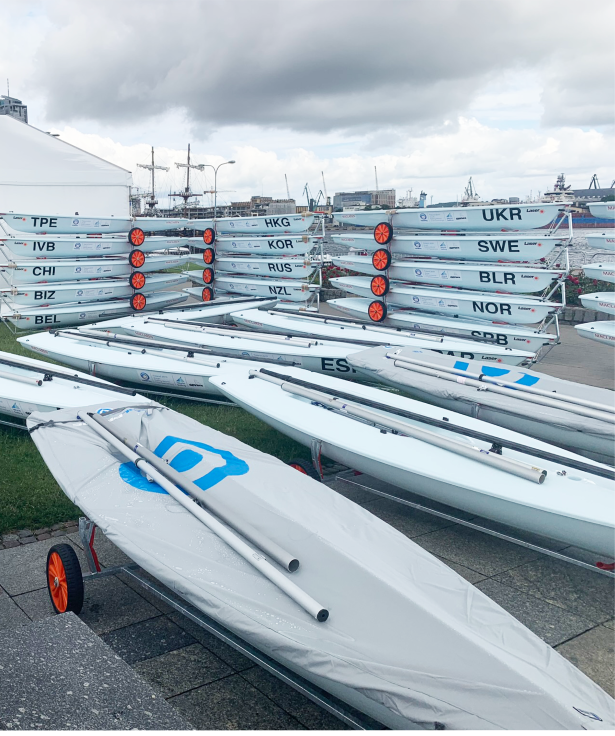
In 2016 a last minute constraint forced World Sailing organisers to move the 2016 World Sailing Youth Worlds Championship to New Zealand. The Australian Builder (which was gifted the rights to New Zealand by LaserPerformance in 1998) declined to support the event and thus World Sailing rushing to LaserPerformance to save the event. With less than 4 months notice, LaserPerformance shipped 110 Lasers from the UK to New Zealand and flew staff over, making the event a success.

LaserPerformance streamlined its UK manufacturing by adding capacity for production of Laser boats and thus doubled the Laser boat market and production from the UK facility to 1,400 boats a year
LaserPerformance acquired the US builder Vanguard Sailboats and consolidated trademark rights in the group territories whilst streamlining its US manufacturing by adding capacity for production of Laser boats and thus doubled the Laser boat market and production from the USA facility to 1,100 boats a year.
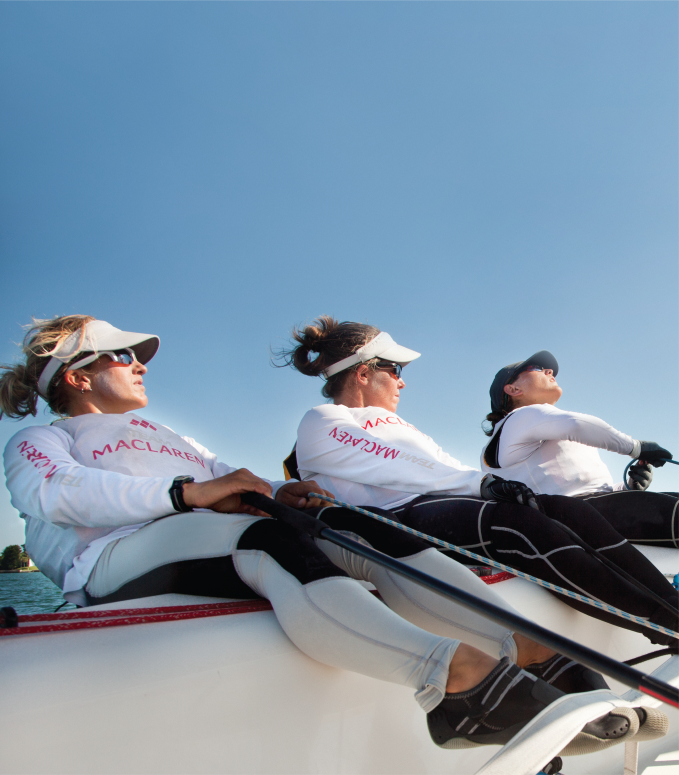
LP entered into a major sponsorship agreement with MACLAREN in support of women in sailing
Team MACLAREN – Anna Tunnicliffe, the 2008 Olympic gold medalist and her crew Molly Vandemoer and Debie Capozzi training for the Olympic Women’s Match Racing campaign. The Team held the Sailing World Cup Women’s Match Racing title for two years.
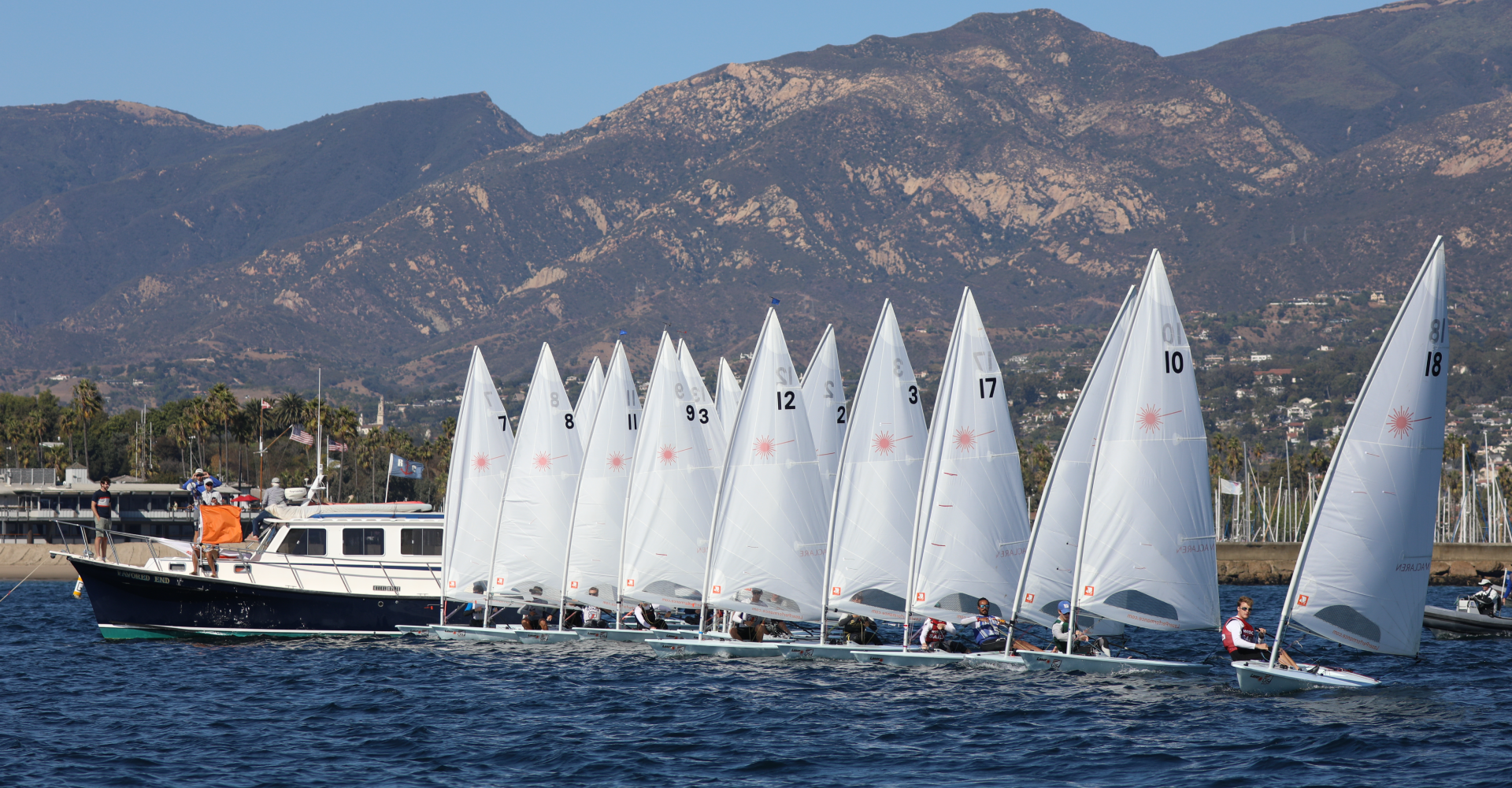
LaserPerformance provided 600 boats for events and races under a major sponsorship program with MACLAREN
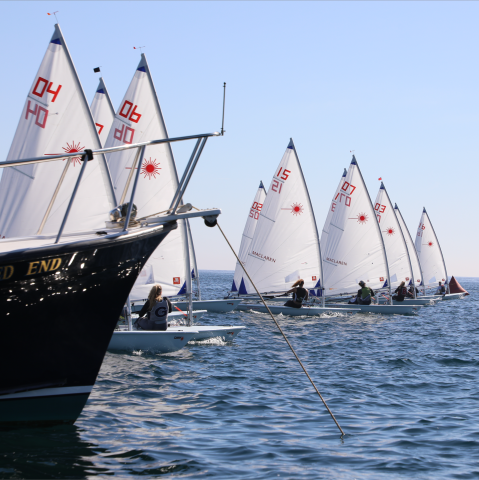
- Parts & Accessories
Privacy Overview
| Cookie | Duration | Description |
|---|---|---|
| cookielawinfo-checkbox-analytics | 11 months | This cookie is set by GDPR Cookie Consent plugin. The cookie is used to store the user consent for the cookies in the category "Analytics". |
| cookielawinfo-checkbox-functional | 11 months | The cookie is set by GDPR cookie consent to record the user consent for the cookies in the category "Functional". |
| cookielawinfo-checkbox-necessary | 11 months | This cookie is set by GDPR Cookie Consent plugin. The cookies is used to store the user consent for the cookies in the category "Necessary". |
| cookielawinfo-checkbox-others | 11 months | This cookie is set by GDPR Cookie Consent plugin. The cookie is used to store the user consent for the cookies in the category "Other. |
| cookielawinfo-checkbox-performance | 11 months | This cookie is set by GDPR Cookie Consent plugin. The cookie is used to store the user consent for the cookies in the category "Performance". |
| viewed_cookie_policy | 11 months | The cookie is set by the GDPR Cookie Consent plugin and is used to store whether or not user has consented to the use of cookies. It does not store any personal data. |

How Much Does A Laser Sailboat Cost?

Key Takeaways
- Depending on what Laser class you pick, each is designed for a specific use
- Prices vary from $900 to $13,000 depending on model, age, new, and used
- Routine maintenance and other factors will contribute to Laser prices overall
- Lasers are one of the most iconic sailing boats you can find including the Sunfish
- Sailors that race with dinghies want a Laser, especially international levels
A Laser sailboat is a popular dinghy used for races and owning one should not break the bank. But how much does a Laser sailboat cost?
Someone can purchase a new Laser sailboat for around $3,300 to $13,000. Used Laser sailboats will cost approximately $2,000 to $6,000. The pricing is typically determined by the year of manufacture, the type of Laser model, and the overall condition.
A variety of factors will influence costs for a Laser sailboat and you will need to narrow down your options based on budget and the intended use of the Laser. According to sailboat listings websites you can find quality used Lasers for reasonable prices.
Table of contents
The Real Cost of a Laser Sailboat
The cost of a new and a used Laser varies unless it is in good condition for used Lasers. The Laser class and boat type will affect the price depending on if you intend to race or just have fun.
Consider aiming for one that best fits your desired activity goal on the water if you need to know which type of Laser boat you want to own. Depending on the route you want to go when purchasing one you can save some money.
Depending on the dealer you buy it from and the model will significantly affect the price. A new Laser sailboat can range up to $13,000 for a Bahia Gennaker and start as low as $6,000 for an XD Standard . A new Sunfish (a Laser sailboat not for racing) can range up to $5,000.
You have the benefit of a boat that is ready to sail and you do not have to worry about previous issues from other owners when purchasing a new Laser. There are Laser dinghies that are designed for racing to choose from. These boats include:
- Laser XD Standard
- Laser XD Radial
- Laser XD 4.7
Each one of those starts at around $6,000. They can go up in price depending on any additional features to your purchase so research which one you like the best.
Used Lasers
A used Laser sailboat will vary in price from $200 (damaged or needs work) to $15,000 (rare or harder-to-find models). When you purchase a used Laser it will require a lot more homework to ensure the Laser dinghy is in good shape. Purchasing a used Sunfish can cost anywhere from $900 to $1,300.
The good news about used Lasers is that you get a fairly decent amount of boaters trying to sell one online. There are plenty of other options to help with your budget even though you might not find a specific year built in mind.
To save money you should search nationwide for deals. Feel free to travel a few states away to grab the perfect arrangement for a Laser dinghy.
Sailboat ownership incurs ongoing insurance expenses for potential harm to:
- Other boats
Coverage costs are based on factors like boat age and size. Comparison shopping can aid in finding the best coverage rates and average annual premiums of $611 in places like Florida.
Older and medium-sized sailboats have less expensive insurance. Laser boats will cost less than a typical sailboat since it is less than 20 feet.
Marina Slips
Marina slip fees vary from $500 to $5,000 for six months and will have lower rates for boats under 30 feet. Stowing a sailboat on dry land can prove to be:
- Cost-effective
- Prevents bottom growth
- Increases longevity
Certain marinas require upfront deposits and provide cheaper dock space with limited amenities. If you want to skip a marina slip you could opt for a trailer and you would need a place to store the boat if you do not have adequate space. Those two factors could be thousands of dollars upfront if you do not have a trailer.
Fees from Sailing Club
Newbie sailors can benefit from sailboat clubs since they offer:
- Racing opportunities
- Sense of community
Expensive initiation fees could range from $1,000 to $4,000 and annual fees of $500 to $1,000 include extras like meals and lockers.
Another option is taking sailing lessons with a qualified instructor to gain water confidence. A club will likely give you access to certain sailing events or other opportunities to join on the water so keep that in mind when weighing your options.
Considering storage and trailer fees is important when owning a boat. Free on-land storage for small sailboats is possible but most require payment. Open storage lots are cheaper than marina slips but larger boats have fewer options.
Winter storage is recommended to protect against cold temperatures. If you do not live near cold climates you should still consider dry storage for parts of the year when not in use.
Routine Maintenance
Maintaining a boat's quality and maintenance history affects upkeep costs. You can prevent most high expenses by avoiding damage and proper use of the boat.
Consistent annual maintenance costs result from buying a boat that has been maintained well or making sure you can give the time and effort to maintain your new boat. One example that could save money in the short term is that you store sails to save replacement costs.
Costly failures can be prevented with proper planning and common sense. Doing the repairs yourself will save you money as long as you do them correctly and hiring someone will double the cost. Maintaining a boat under 30 feet typically costs about $2,000 per year to maintain.
How to Find Used Laser Sailboats?
Finding a used Laser sailboat can help you save thousands of dollars depending on the model and age of the boat. Laser sailors will need to do a little more homework if they wish to compete in Laser sailing.
There are plenty of deals to buy good quality boats whether it is Laser dinghies or a Sunfish. Checking local marinas or places that store boats or anything besides a dealer could be your best bet. Most Laser sailboats should still hold their value if the owner showed them some love over the years.
Here are some tips for finding the best deal on a Laser boat.
- Properly examine the hull for a smooth surface without damages or heavy marks
- Check for consistent firmness and avoid areas that feel soft
- Opt for dry-sailed boats that were kept on land and stored for protection
- Watch out for water saturation and extra weight caused by improper storage
- Look for a weight similar to the manufacturer's dry weight to get the best performance
- If you find a used Sunfish you should aim for a weight that matches new boats for racing intentions
Why Would You Purchase a Laser Sailboat?
The Laser is a widely acclaimed adult racing boat that features a standardized box one design that guarantees fair competition for Laser sailing. This is solely dependent on the sailor's abilities and not the boat.
Racing with a Laser sailboat is a unique experience. With its demanding athleticism, subtle steering, trimming techniques, and tactical expertise, it challenges even the most skilled Laser sailors. Sailors of different ages and skill levels compete in the Laser sailboat.
These are available in two hardware versions known as XD for racing enthusiasts and Race for recreational and club sailing. Both versions offer three rig options to accommodate athletes of different sizes and ages such as:
Related Articles
Daniel Wade
I've personally had thousands of questions about sailing and sailboats over the years. As I learn and experience sailing, and the community, I share the answers that work and make sense to me, here on Life of Sailing.
by this author
Learn About Sailboats
Most Recent

Affordable Sailboats You Can Build at Home
September 13, 2023

Best Small Sailboat Ornaments
September 12, 2023
Important Legal Info
Lifeofsailing.com is a participant in the Amazon Services LLC Associates Program, an affiliate advertising program designed to provide a means for sites to earn advertising fees by advertising and linking to Amazon. This site also participates in other affiliate programs and is compensated for referring traffic and business to these companies.
Similar Posts

Discover the Magic of Hydrofoil Sailboats
December 11, 2023

Hunter Sailboats: Are They Built for Bluewater Cruising?
August 29, 2023

What Is A Furler On A Sailboat?
August 22, 2023
Popular Posts

Best Liveaboard Catamaran Sailboats
December 28, 2023

Can a Novice Sail Around the World?
Elizabeth O'Malley
June 15, 2022

4 Best Electric Outboard Motors

How Long Did It Take The Vikings To Sail To England?

10 Best Sailboat Brands (And Why)
December 20, 2023

7 Best Places To Liveaboard A Sailboat
Get the best sailing content.
Top Rated Posts
© 2024 Life of Sailing Email: [email protected] Address: 11816 Inwood Rd #3024 Dallas, TX 75244 Disclaimer Privacy Policy
Become the Confident Skipper of Your Own Sailboat
What is a laser dinghy the simple basics behind it’s sailing.
- Post author: Anns
- Post published: November 9, 2022
- Post category: Uncategorized
- Post comments: 0 Comments
Introduction
Sailing can be a very exciting sport, and it’s something that anyone can do. You don’t need to go to the Olympics or be an expert sailor either; the basics of sailing are easy to learn when you have someone teach them to you! We’ll cover everything from what lasers are, how they work, and what makes them different from other boats on the water. Then we’ll talk about learning how to sail in general as well as tips for getting started with your own Laser dinghy.
All you need to know about the Laser
A Laser is a single-handed dinghy. It is used in dinghy sailing, which is a type of sailing competition. A Laser can also be used for training sailors and teaching them how to sail.
The Laser class was first built in the 1950s, with the first official race taking place in 1963 at Oyster Bay on Long Island Sound in New York State. It was designed specifically for use by college students who wanted to learn how to sail boats before they graduated and started working full time.
Sailing the dinghy
Sailing the Laser:
A laser dinghy is a small, single-person boat that uses a centerboard to control its direction. It is very similar to a Sunfish, which has been called the “poor man’s sailboat” because it can be purchased for under $1,000 and sailed in freshwater lakes or ponds.
Learning how to sail is easy with these two boats because they are simple enough for anyone who wants to learn how to sail without having any prior experience with sailing. The Sunfish and Laser also have similar wind and water conditions as far as where they can be used and what type of weather conditions they can withstand.
Learning how to sail
Learning how to sail, or at least the basics of sailing, is an exciting endeavor. It can be overwhelming, and that’s okay. The first step is getting your hands on a boat and learning what all the parts are called so that you can then understand how they work together and how they help you move through the water.
The boat itself has three main parts: bow (front), stern (back), and centerboard (also called a daggerboard). When sailing in lighter winds without much windage from waves or other boats, these can be enough for moving forward with ease; however, if there is more force against the boat than it can withstand by using just its own built-in momentum alone then it will stall out or turn over completely from being overpowered by too much force coming from an outside source such as another vessel traveling faster than yours does—or even strong winds blowing directly against where your line of travel would normally take place! That’s why we need more tools besides just our hull itself….
Information about sailing
Laser dinghies are fast, fun, and easy to sail. They’re great for racing or training because they’re so light, easy to transport, and can be sailed by one or two people.
So, there you have it! We hope that this post has helped you to learn more about the sport of sailing and how it can be exciting, fun and safe for anyone. If you want more information about our sailing club or want to join us on a trip out on the water then please contact us at the club house or give us a call!
You Might Also Like
5 essential tips for safe sailing, luxury at its best, leave a reply cancel reply.
Save my name, email, and website in this browser for the next time I comment.
Fast Dispatch, Fast Delivery and a 5 Star Rated Service

- MENS SAILING CLOTHING
- DYNEEMA TRAPEZE LINES AND ROPES
- SINGLE SHEAVE BLOCKS
- Gelcoat Fillers
- Dry Lubricants
- Adhesive Glues
- Hooks & Clips
- Catamaran Launching Trollies
- Jockey Wheels
- Hitch Locks
- Lighting Board
- Breakaway Cables
- Clew Straps
- Upper Masts
- Lower Masts
- Rope Thimbles
- Wind Indicators & Burgees
- Parrel Beads
- Whipping Twine
- Sailmakers Palm
- Digital Compasses
- DEVOTI ILCA
- LASER SAIL BOATS & DINGHYS
- BAHIA SAIL BOATS & DINGHYS
- Numbers & Letters
- Dinghy Covers
- Under Covers
- Catamaran Covers
- Single Handed
- Double Handed
- 18 Foot Skiff
- Exocet Moth
- Musto Skiff
- Dart 15/ Sprint 15
- Hurricane 5.9
- Laser Bahia
- Laser Cascais
- Laser Funboat
- Laser Stratos
Your Cart is Empty
- £0.00 Subtotal
Tax included and shipping calculated at checkout
Order before midday Monday to Friday and we will ship your order the same day.
- 01268 222912
- Accessories
- Laser Products
- Sails & Covers
- Rope Lengths
- Parts By Boat
- Boat Care & Cleaning
- Splicing Tools
- Boat Covers
- Dinghy Rope Lengths
- Laser Rope Lengths
- RS Rope Lenghts
- Catamaran Rope Lengths
- Laser Performance
- Topper Sailboats
- Other Boats

Pay in 30 days or split over 3 months
- Mens Sailing Clothing
- Womens Sailing Clothing
- Junior Sailing Clothing
- Repair Kits
- Skiff Suits
- Life Jackets
- Trapeze Harnesses
- Buoyancy Aids
- Hiking Pads & Pants
- Hiking / Toe Straps
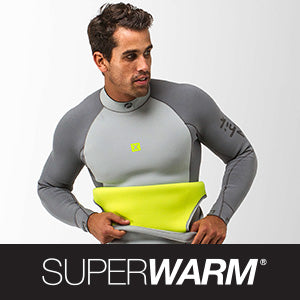
Zhik Superwarm
- 100m Rope Reel
- 50m Rope Reel
- Polyester Ropes
- Control Lines
- Double Braids
- Braid On Braid
- Anchor Lines & Ropes
- Spools & Reels
- Windsurfing
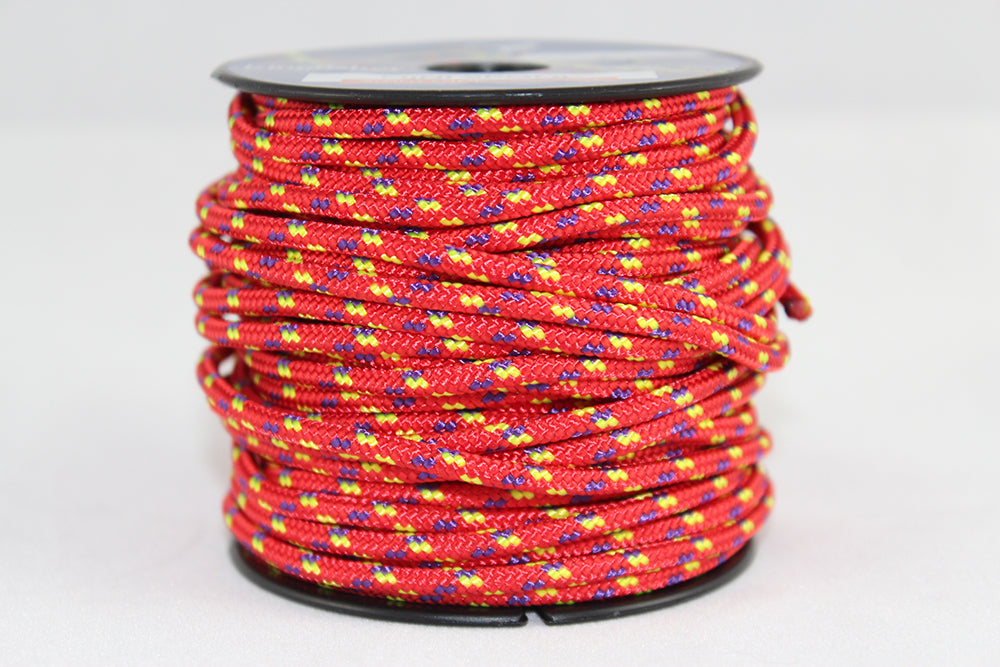
Mini Spools
- Single Block
- Double Block
- Triple Block
- Soft Attach
- Split Rings & Pins
- Inspection Hatches & Covers
- Bungs & Sockets
- Rudder & Tiller Parts
- Bushes & Fairleads
- Marine Screws
- Penny Washers
- VHF Aerials & Antennas
- Marine Tapes
- Traveller Systems And Parts
- Traveller Blocks
- Pico Hull & Deck Fittings
- Hull & Deck Fittings
- Laser Boats
- Laser Sails
- Laser Sail Packages
- Laser Spars
- Laser Rig Packages
- Laser Foils
- Laser Hull & Deck Fittings
- Laser Ropes
- Laser Dinghy Covers
- Devoti ILCA Boats
- ILCA Sail Packages
- ILCA Rig Package
- Devoti D-Zero Boats
- Devoti D-Zero Parts
- Devoti KDK Boats
- ILCA Charter Boats
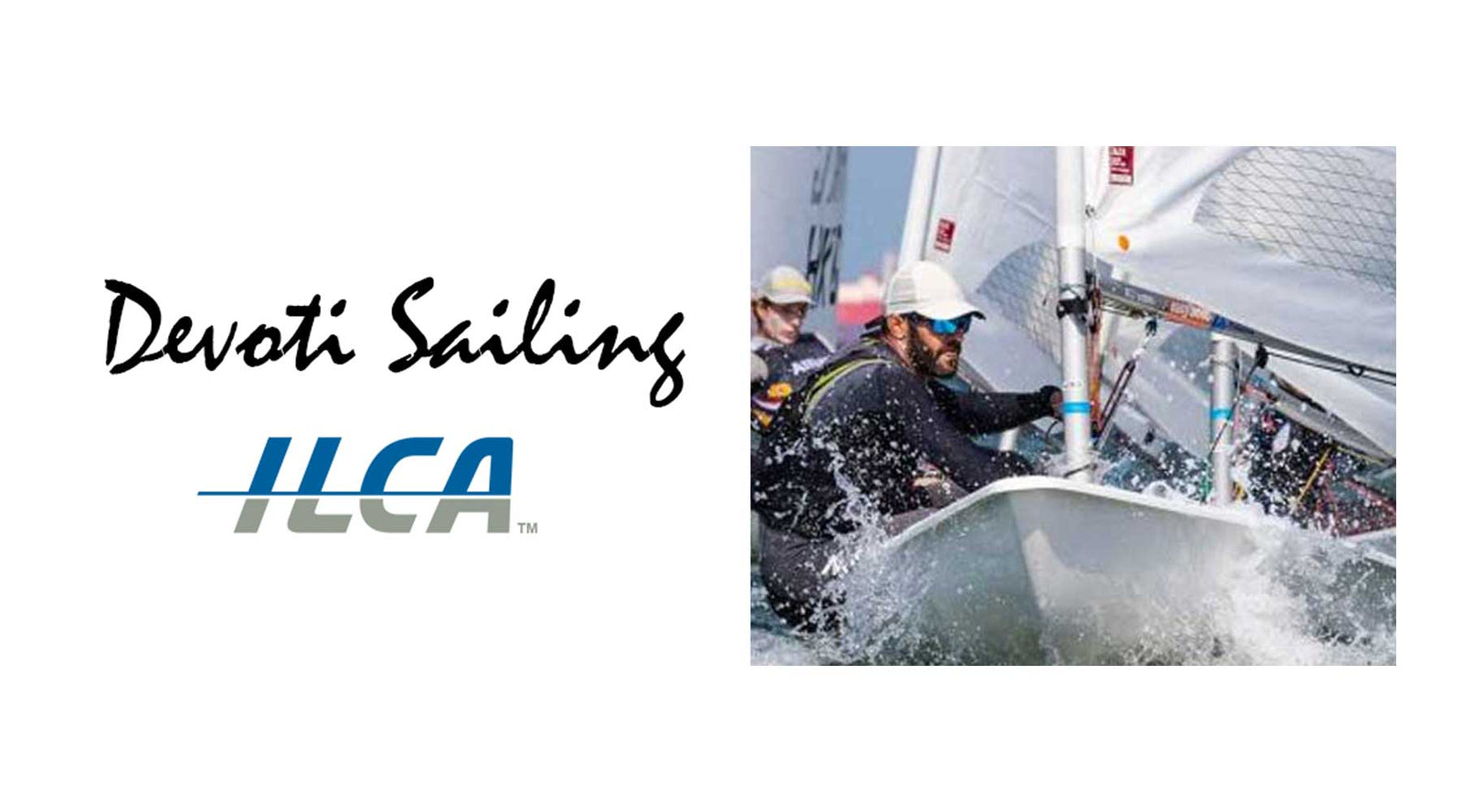
New Devoti ILCA
Search our chandlery

Laser Sailing - How to get started
August 17, 2018 4 min read
So, you're looking into Laser Sailing but maybe you're not sure how to get started with buying a Laser and keeping it sailing. Well you've come to the right place, as an authorised Laser Performance boat and parts dealer we can help.
First of all, it's important to say the Laser is a great boat, first introduced at the 1971 New York Boat Show it's gone from strength to strength with it being the choice of Olympic sailing for both men and women and with over 200,000 being built to date. In the UK there is a very active class association with events up and down the country with hundreds of boats attending the larger events.
Laser Sailing Boat Key Facts
- Year of design - 1969
- No of sailors - 1
- Draft - 0.787m
- Hull weight - 58.97kg
- LWL - 3.81m
- Beam - 1.39m
- Rig types - Standard (full rig), Radial and 4.7

Buying a Laser Sailing Dinghy
There are two options when buying a new Laser sailing dinghy.
The large majority of people starting off with a Laser will buy second hand, there are a number of places in the UK where you can source a second hand Laser, here are just some examples:
- Apollo Duck
- Dinghies and Dinghy Bits for Sale Facebook Group
- Yachts and Yachting Magazine
- Club Notice Boards - worth looking at a busy Laser Sailing club
If you are thinking of buying a new boat then you've come to the right place. Sailing Chandlery have boats readily available and can tailor a package to suit your sailing needs.
The easiest way to get started is to review the Laser boats for sale on our website along with prices and then give us a call to tailor your package.
You can call us on 07793 953564.
Which Laser rig?
The superb thing about the Laser is that it can be a boat for many different people and is especially a great boat for smaller youth sailors who will grow over time and can simply swap in and out the three different rig options.
The rigs available are:
- Laser Standard - traditionally for men
- Laser Radial - traditionally for lady and youth sailors
- Laser 4.7 - traditionally for youth sailors

Although the above is what has typically happened in the past we've seen plenty of female and youth sailors sailing a Laser standard, it's simply down to personal preference. You could have a full (standard) rig for light winds and then a radial for the windier days.
You'll save a bit of money on a Laser 4.7 sailing boat because the sail is slightly cheaper. The radial and standard sails are the same price so the boat package prices do not differ.
What's included with a new Laser boat?
Many Laser dealers (Laser Performance included) will give you a price that looks attractive until you realise that a launching trolley and boat cover isn't included. For us these are essentials for when you're buying a new boat so we've created packages which include these essential items.
If you were to buy a package from Sailing Chandlery you would receive the following:
- Spars to include mast sections (depending on rig chosen) and boom
- Carbon composite top mast section
- Tiller and tiller extension
- Class Legal Sail (depending on rig chosen)
- All blocks and pulleys needed
- Launching trolley
- PVC boat cover (polycotton breathable covers are also available as an extra)
This is essentially everything you need to get sailing and to start to enjoy your brand new Laser.
Additional options such as different sized rigs, road trailer, under cover and much more are also available - let us tailor a custom package for you, you won't be disappointed.
Spare Parts
Have you bought an older boat and need to get it refreshed?
As one of only a few official Laser Performance dealers in the UK we are able to help and carry a large range of Laser parts and spares in stock ready for dispatch.
In our experience, the most popular upgrades for a Laser purchased second hand are:
- XD kit upgrade - many older Lasers still have the traditional control line systems
- New sail - there are three different types of sail - Training, Class Compliant and Class Legal - you might not need to spend the money on an official class legal sail
- Different rig - we provide rig packages so you can get everything you need as one tailored product
- Zhik Laser Toe Strap
Time to Learn
This is all about time on the water, get out there, start sailing and enjoy the Laser sailing dinghy.
If you want the best reading on the Laser we would recommend The Laser Book.
Got questions? We're always happy to help, whatever the question please contact us and ask away.
Recent Articles
- Looking After You ILCA Spars
- ILCA Outhaul Calibration Markers
- ILCA Daggerboard Calibration Sticker
- 90˚ Marked Laser/ILCA Main Sheet - Sailing Chandlery
- Pre season Check List
- Where Should My ILCA Tell Tales Go
- What Are The Basic Tools Needed To Start Rope Splicing?
- You Don't Always Need Dyneema
- Boat Care and Cleaning Products
- Ropes for Club Boats and Club Dinghies - The Bosuns Guide
Let customers speak for us
Used 2 of these to replace the little plastic ones on a supernova tiller. Much better and now pull in the right direction
This is the perfect tool to assist in tightening my Dart Trampoline. It grips the rope far better than you can with your hands.
After having my Previous Superwarm X Suit for over 5 years whilst working as a watersports instructor this is a great improvement over the previous suit. Warmer and softer linning throughout the inside of the suit and I will continue to use the suit all year round like my old suit.
Someone at the club “borrowed “ one of my Solo’s bungs. I bought two so now I have a spare.
Great to have something that goes over everything if a quick solution is required
had ordered one on amazon before, received the wrong size received the correct size now :)
A simple moulded part of good quality, supplied quickly and well packed.
Turned out that I had ordered the wrong make, my camcleats being Allen not Harken, however by drilling the two fixings holes out by 1mm and filing two small notches they fitted perfectly.
Super helpful company. Attentive, and quick to deliver.
Second time I have use for this purpose. Really easy to attach to alloy mast and so easy and positive to operate.
We have put the boat on this trolley but not yet used it for launch and recovery. First impressions are very good, It fits together well and is super easy to assemble - it's made to put together and take apart fast if you want to put it in a vehicle etc. It is very lightweight which should be a boon launching and recovering the boat - at the same time it looks strong and well made. Being aluminium we won't have a rust problem either. I was impressed how it fits perfectly wherever it supports the boat. So assuming it performs well in use we are pleased we got this. Very helpful guy on the phone and it came quickly so all good, thanks,
Good service, and fast delivery. Very happy with my large amount of assorted short lengths of rope of many different thicknesses for practising my knots.
Good quality rope that can be spliced. Delivered promptly by the Sailing Chandlery.
Excellent sail, ideal for training and comes with a sailbag, Our only drawback was the long delivery time (2-3 weeks) and having to pay €90 in customs charges all due to Brexit! If Sailing Chandlery had a outlet here in the Republic or in Northern Ireland, business could get much better.
Worked a treat
The Puco hatches I bought hatch really well for hatchy things. Speedy service and great value. Hatch-on!
SIGN UP TO OUR NEWSLETTER
Save up to 40% on your next order.
The Thrill of Laser Sailing: A Comprehensive Guide
The world of sailing is vast, pulsating with exciting possibilities and various types of boats for every kind of sailor. One such remarkable vessel that has dominated the sailing landscape for its remarkable speed, agility and ease of use is the laser sailboat.

What Exactly is Laser Sailing?
Laser sailing is a popular form of sailing that utilizes a laser class dinghy, a small sailboat designed for one or two people. The term ‘laser’ refers to the specific design and build of the sailboat, which is characterized by its simplicity and affordability. It is often used for training beginners as well as in competitive sailing due to its international recognition as a class of sailboat in the Olympic games.
Why Choose Laser Sailing?
The rising popularity of laser sailing is due to a number of reasons. Firstly, the laser class dinghy is one of the most affordable sailboats on the market. This makes sailing more accessible to a wider audience, as the financial barrier is significantly reduced.
Secondly, the simplicity of the laser sailboat design makes it easy for beginners to learn how to sail. The laser sailboat only has two lines to manage; the main sheet and the vang. This allows new sailors to focus on mastering the basics of sailing without getting overwhelmed.
Lastly, laser sailing offers an incredibly thrilling experience. The small size of the boat combined with its impressive speed capacity allows for a unique and exhilarating sailing experience.
The Intricacies of Laser Sailing
Understanding the basics of laser sailing is just the start. To truly master this form of sailing, one must delve deeper into the intricate details. This includes understanding the laser sailboat’s rigging, the sailing techniques, and the rules of competitive laser sailing.
The Rigging of a Laser Sailboat
The rigging of a laser sailboat is simple yet effective. The sailboat consists of a hull, a single sail, a mast, and a rudder. Due to its simplicity, it is quick and easy to rig a laser sailboat. However, rigging the sailboat correctly is crucial. Failure to do so can result in poor performance or even damage to the boat.
Mastering Laser Sailing Techniques
While laser sailing shares many techniques with other forms of sailing, there are a few specific techniques that every laser sailor must master. These include, but are not limited to, mastering the appropriate body positioning, understanding the sail settings for different wind conditions, and executing quick and efficient turns.
Competitive Laser Sailing
If you have mastered laser sailing techniques and are ready to test your skills, competitive laser sailing is the next step. It’s not only about speed, the success in a laser sailing race also depends on your strategy, understanding of wind shifts, and efficient boat handling.
Concluding Thoughts on Laser Sailing
Laser sailing is a thrilling and accessible form of sailing that is beloved by beginners and professional sailors alike. From mastering the elegant simplicity of the laser sailboat to feeling the adrenaline rush as your sailboat glides over the water, laser sailing offers an experience that is unlike any other. Let this comprehensive guide enlighten you about the nuances of laser sailing and encourage you to embark upon this exhilarating journey.
Related Posts

San Diego Surfing: Riding the Perfect Wave
San Diego surfing is synonymous with sun-kissed beaches, friendly locals, and pristine waves that beckon…

Red River Gorge Kayaking: An Avid Adventurer’s Dream Trip
The Red River Gorge in Kentucky is a paradise for outdoors enthusiasts. With towering cliffs,…
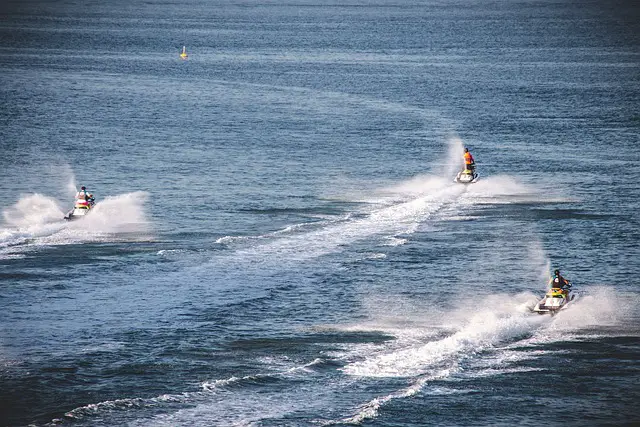
Jetskiing in Wildwood: The Ultimate Weekend Adventure
Are you looking for an unforgettable outdoor experience this summer? If you’re coming to Wildwood,…
Great choice! Your favorites are temporarily saved for this session. Sign in to save them permanently, access them on any device, and receive relevant alerts.
- Sailboat Guide
Laser (International)
Laser (International) is a 13 ′ 8 ″ / 4.2 m monohull sailboat designed by Bruce Kirby and Ian Bruce and built by Performance Sailcraft and LaserPerformance starting in 1970.

- 2 / 16 Deltaville, VA, US 1987 Laser (International) $2,750 USD View
- 3 / 16 Sloatsburg, NY, US 2014 Laser (International) $3,650 USD View
- 4 / 16 Deltaville, VA, US 1987 Laser (International) $2,750 USD View
- 5 / 16 Sloatsburg, NY, US 2014 Laser (International) $3,650 USD View
- 6 / 16 Deltaville, VA, US 1987 Laser (International) $2,750 USD View
- 7 / 16 Sloatsburg, NY, US 2014 Laser (International) $3,650 USD View
- 8 / 16 Deltaville, VA, US 1987 Laser (International) $2,750 USD View
- 9 / 16 Sloatsburg, NY, US 2014 Laser (International) $3,650 USD View
- 10 / 16 Sloatsburg, NY, US 2014 Laser (International) $3,650 USD View
- 11 / 16 Deltaville, VA, US 1987 Laser (International) $2,750 USD View
- 12 / 16 Sloatsburg, NY, US 2014 Laser (International) $3,650 USD View
- 13 / 16 Sloatsburg, NY, US 2014 Laser (International) $3,650 USD View
- 14 / 16 Sloatsburg, NY, US 2014 Laser (International) $3,650 USD View
- 15 / 16 Sloatsburg, NY, US 2014 Laser (International) $3,650 USD View
- 16 / 16 Sloatsburg, NY, US 2014 Laser (International) $3,650 USD View

Rig and Sails
Auxilary power, accomodations, calculations.
The theoretical maximum speed that a displacement hull can move efficiently through the water is determined by it's waterline length and displacement. It may be unable to reach this speed if the boat is underpowered or heavily loaded, though it may exceed this speed given enough power. Read more.
Classic hull speed formula:
Hull Speed = 1.34 x √LWL
Max Speed/Length ratio = 8.26 ÷ Displacement/Length ratio .311 Hull Speed = Max Speed/Length ratio x √LWL
Sail Area / Displacement Ratio
A measure of the power of the sails relative to the weight of the boat. The higher the number, the higher the performance, but the harder the boat will be to handle. This ratio is a "non-dimensional" value that facilitates comparisons between boats of different types and sizes. Read more.
SA/D = SA ÷ (D ÷ 64) 2/3
- SA : Sail area in square feet, derived by adding the mainsail area to 100% of the foretriangle area (the lateral area above the deck between the mast and the forestay).
- D : Displacement in pounds.
Ballast / Displacement Ratio
A measure of the stability of a boat's hull that suggests how well a monohull will stand up to its sails. The ballast displacement ratio indicates how much of the weight of a boat is placed for maximum stability against capsizing and is an indicator of stiffness and resistance to capsize.
Ballast / Displacement * 100
Displacement / Length Ratio
A measure of the weight of the boat relative to it's length at the waterline. The higher a boat’s D/L ratio, the more easily it will carry a load and the more comfortable its motion will be. The lower a boat's ratio is, the less power it takes to drive the boat to its nominal hull speed or beyond. Read more.
D/L = (D ÷ 2240) ÷ (0.01 x LWL)³
- D: Displacement of the boat in pounds.
- LWL: Waterline length in feet
Comfort Ratio
This ratio assess how quickly and abruptly a boat’s hull reacts to waves in a significant seaway, these being the elements of a boat’s motion most likely to cause seasickness. Read more.
Comfort ratio = D ÷ (.65 x (.7 LWL + .3 LOA) x Beam 1.33 )
- D: Displacement of the boat in pounds
- LOA: Length overall in feet
- Beam: Width of boat at the widest point in feet
Capsize Screening Formula
This formula attempts to indicate whether a given boat might be too wide and light to readily right itself after being overturned in extreme conditions. Read more.
CSV = Beam ÷ ³√(D / 64)
First selected as Olympic class in 1996.
Embed this page on your own website by copying and pasting this code.

- About Sailboat Guide
©2024 Sea Time Tech, LLC
This site is protected by reCAPTCHA and the Google Privacy Policy and Terms of Service apply.

IMAGES
VIDEO
COMMENTS
Laser (dinghy) The Laser is a class of single-handed, one-design sailing dinghies using a common hull design with three interchangeable rigs of different sail areas, appropriate to a given combination of wind strength and crew weight. Ian Bruce and Bruce Kirby designed the Laser in 1970 with an emphasis on simplicity and performance.
Laser Standard / MK2 / ILCA 7. This is the most common Laser rig size, and the original rig on the boat when it was designed. It features a 7.06 square meter sail (about 76 square feet). In 2018, the Laser Class approved a new 'Standard' sail, which is referred to as the 'MKII' or 'Mark 2' to distinguish it from the first version.
Types of Laser Sailboats. Laser sailboats are a type of one-design dinghies, which means that they follow strict design and manufacturing rules to ensure all boats in the Laser class are identical. The versatile laser class is widely popular as they offer different sail and rig sizes, catering to sailors of various ages, weights, and skill ...
The Laser Dinghy - 3 Sailboats In 1. The Laser Dinghy - 3 sailboats in 1. The laser dinghy comes in 3 rig sizes: 4.7 / ILCA 4. Radial / ILCA 6, and. Full/Standard / ILCA 7 rig. This means that sailors of just about any ability or age can enter the sport, and advance with minimal cost. Rigging is easy using a sleeved sail over a mast with no ...
A laser sailboat is a type of sailboat that is designed to take advantage of the power of laser technology. It is a single-handed, small sailboat that is designed to be sailed with minimal crew and minimal equipment. The hull is designed to be lightweight and sleek, providing the boat with maximum speed and maneuverability.
Originally known as the Laser, the ILCA dinghy is a single-handed racing dinghy. The biggest attraction of the ILCA dinghy is that it is protected by strict one-design class rules, which means that no changes are allowed to the boat unless they are specifically permitted in the rules. The result is that all ILCA boats are virtually identical ...
This allows sailors of different ages, weights and abilities to participate in a single class. The rigs are: Laser Standard (ILCA 7) Laser Radial (ILCA 6) Laser 4.7 (ILCA 4) Masts/Spars. Each Laser rig consists of three pieces - the bottom mast, top mast and boom. The bottom mast is specific to each rig size, but the same top section and boom ...
1. Sailboat Number. Most dinghies have sailboat numbers on their cockpit's back or the deck. These numbers usually help to identify the age and quality of the sailboats. The newer ones tend to have the numbers etched on their cockpit's backs, while the older dinghies have these numbers written on their decks. 2.
A Laser sailboat typically features a 4.23-meter length hull, weighing approximately 59 kg, making it portable and easy to manage. It's equipped with a single sail, typically ranging from 4.7 to 7.06 m² based on the rig variant, which makes it versatile for different sailing conditions and sailor's abilities.
Introduction to Laser Sailing. April 3, 2018 Katie Olsen How To. by Jon Emmett. The Laser is truly the boat for all ages from our Junior 4.7s to our legendary (over 75 year old) Masters. No other adult class is raced in more countries in the World, in a class which takes grass roots to Olympic sailors. Come and join us to see why!
4.7 Rig - Designed for smaller sailors 110 - 140 lbs. (50 - 65 kg). Radial Rig - Used as the women's Olympic class, and designed for sailors 140 - 175 lbs. (65-80 kg). Full or Standard Rig - Used as the men's Olympic class, and designed for sailors 165 lbs.+ (75 kg+)."Olympic sailors are in the 180 lbs. range but club sailors ...
The Laser is the world's most popular adult racing class boat. True to box one design standards, each Laser in the world is identical ensuring the best sailor on the water wins the race, not the boat. The Laser is a challenging boat that rewards athleticism, subtle steering and trimming techniques, as well as the tactical excellence of the sailor.
The laser is an Olympic class boat which first made an appearance in Atlanta in 1996. The class ensures the one - design rules allow sailors to excel based on their ability to sail the boat, not the condition of the sails etc. ... There are three types of Laser sails, Official Class Legal Sails, Class Compliant Sails and Training Sails ...
With the mast in place, slot the boom into the mast, and tie off the outhaul to the sail clew using a bowline, as shown in the knots section. Then attach the clew tie-down, making sure to tie it underneath the outhaul. Close-up of laser clew tie-down and outhaul. Attach the vang and cunningham. Tie a small loop in the end of the cunningham and ...
Over 200,000 Laser sailboats have been built over the last 40 years, more than most other small dinghy sailboats. In this article we are going to answer some of the common questions we receive about the basics of Laser sailboat rigging, how to tell what size rig you have, what you can upgrade, and more. This information is designed for the ...
Short answer laser 2 sailboat: The Laser 2 sailboat is a high-performance sailing dinghy designed for racing and recreational sailing. It features a single trapeze, a mainsail, and a jib, providing exciting and responsive sailing experiences. Its hull is made from fiberglass, making it durable and lightweight. Introduction to the Laser 2 Sailboat: Experience the
HISTORY. Laser now rules the waves around the world in over 50 countries. During that time LaserPerformance has been there supplying the most sought-after Lasers and supporting the growth of the Laser sailing community around the world. "There have been more than 200,000 Lasers built around the world, the biggest number of any boat ever.
There are many types of sailboat rigging, and some are more beginner-friendly than others. Unfortunately, some of the most aesthetically pleasing rigs are also the most complicated. ... Used Laser sailboats are available on the market, though usually not as common as the Sunfish. Used Laser prices vary widely. 2) Gaff-Rigged Catboat.
Someone can purchase a new Laser sailboat for around $3,300 to $13,000. Used Laser sailboats will cost approximately $2,000 to $6,000. The pricing is typically determined by the year of manufacture, the type of Laser model, and the overall condition. A variety of factors will influence costs for a Laser sailboat and you will need to narrow down ...
A laser dinghy is a small, single-person boat that uses a centerboard to control its direction. It is very similar to a Sunfish, which has been called the "poor man's sailboat" because it can be purchased for under $1,000 and sailed in freshwater lakes or ponds. Learning how to sail is easy with these two boats because they are simple ...
In the UK there is a very active class association with events up and down the country with hundreds of boats attending the larger events. Laser Sailing Boat Key Facts. Year of design - 1969; No of sailors - 1; Draft - 0.787m; Hull weight - 58.97kg; LOA - 4.2m; LWL - 3.81m; Beam - 1.39m; Rig types - Standard (full rig), Radial and 4.7; Buying a ...
The world of sailing is vast, pulsating with exciting possibilities and various types of boats for every kind of sailor. One such remarkable vessel that has dominated the sailing landscape for its remarkable speed, agility and ease of use is the laser sailboat. ... The laser sailboat only has two lines to manage; the main sheet and the vang ...
Laser (International) is a 13′ 8″ / 4.2 m monohull sailboat designed by Bruce Kirby and Ian Bruce and built by Performance Sailcraft and LaserPerformance starting in 1970. ... This ratio is a "non-dimensional" value that facilitates comparisons between boats of different types and sizes. Read more. Formula. SA/D = SA ÷ (D ÷ 64) 2/3.